The Temple in Operation
Richard O. Cowan, "The Temple in Operation" in A Beacon on A Hill: The Los Angeles Temple (Religious Studies Center, Brigham Young University; Salt Lake City: Deseret Book, 2018), 163–194.
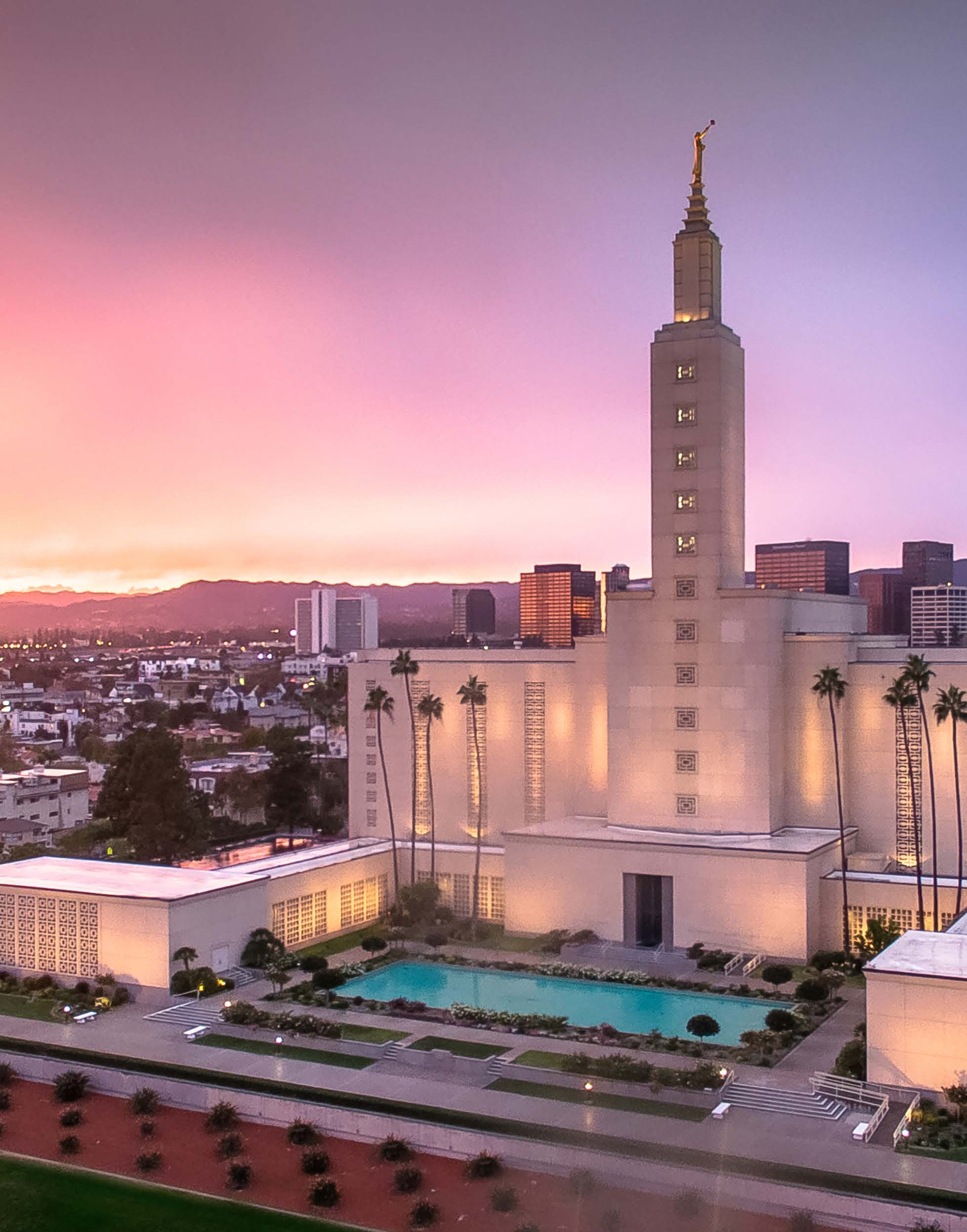
1955 Benjamin L. Bowring is named first temple president (November)
1956 Temple is dedicated by President David O. McKay (March 11–14)
First baptisms for the dead (Saturday, March 24)
First couple is sealed for eternity (Friday, March 30)
First endowments are given, by audio recording (Saturday, April 14)
1958 Films are used in presenting endowment (January)
1966 Temple patrons apartments open
1978 Deaf patrons perform first sealings
1981 Temple opens overnight to mark twenty-fifth anniversary and remodeling (March 20–21)
1993 Dedication of San Diego Temple (April) cuts district and hence activity
1994 Powerful earthquake causes some damage at the temple (January 17)
2006 Stake commemoration Saturdays mark fiftieth anniversary
2012 Homes are built for temple and mission presidents
While Southern California Latter-day Saints had looked forward to serving in their new temple, they had also made preparations for this opportunity. For example, several stakes conducted special genealogical courses to help members know how to identify ancestors for whom temple ordinances needed to be performed. Eventually a portion of the visitors’ center basement became a genealogical library as part of the Church’s worldwide family history program. Another essential part of this preparation was putting in place the key personnel who would be responsible for operating the new temple.
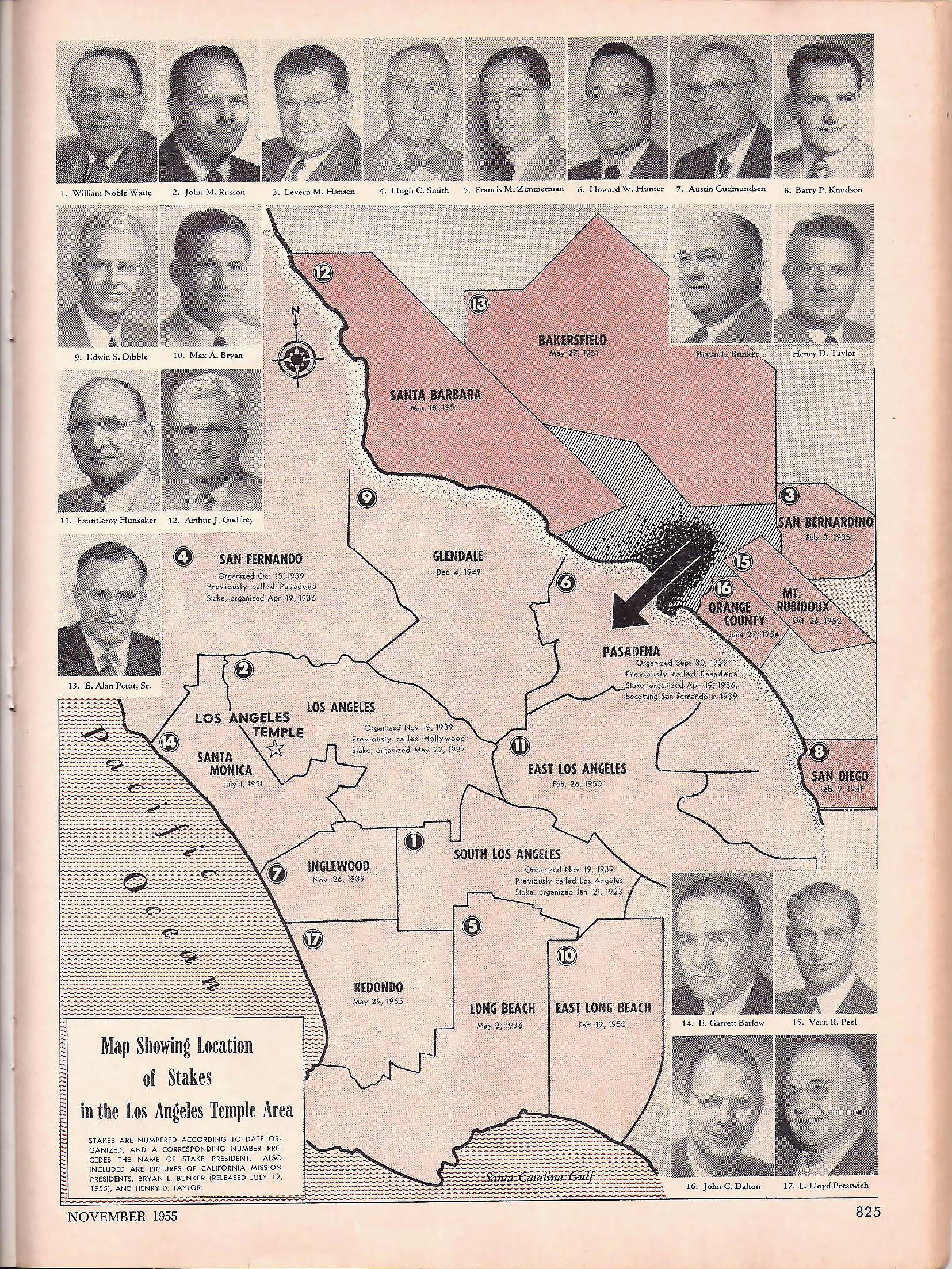 Stakes, presidents, and boundaries in the Los Angeles Temple area. (Improvement Era, November 1955)
Stakes, presidents, and boundaries in the Los Angeles Temple area. (Improvement Era, November 1955)
Temple Leaders and Workers Called
Typically the first permanent appointment is the temple engineer, who will be responsible for the functioning of the temple’s physical plant. Generally he is selected several months before the completion of construction, so he can become thoroughly acquainted with the building’s electrical, plumbing, ventilation, and other mechanical systems and how to maintain them. This was the case with the Los Angeles Temple. Joseph Derbyshire, a native of England who had been employed thirty-six years as electrical maintenance supervisor at Utah Power and Light, was named temple engineer. He began his service July 1, 1955, over eight months before the temple was dedicated.[1]
The next appointment announced was the call of Benjamin L. Bowring to become the temple’s first president. President David O. McKay personally made this announcement at a press conference in the bureau of information on November 28, 1955, just as the open house was about to begin. Born in Brigham City, Utah, on September 1, 1903, President Bowring had an extensive and varied background in Church service. He served in the presidency of the Salt Lake Stake, as an ordinance worker in the Salt Lake Temple, and presided over the Texas-Louisiana Mission. At the time of his appointment to Los Angeles, Bowring had been presiding over the Hawaii Temple in Laie for two years. When President Bowring and his wife, Leone Rampton Bowring, arrived in California at Christmas time, he commented that they would enjoy serving there as much as in the islands. “We are happy to be engaged in the Lord’s work wherever it may be.”[2]
Another key appointment, made in December 1955, was the selection of the temple recorder. Called to this position was A. Bent Peterson, who since 1942 had been serving as a counselor in the Manti Temple presidency. Born in Greeley, Colorado, on July 22, 1908, he became a recorder in the Manti Temple in 1932. Together with his wife Mary and their two children, he moved to Los Angeles in January 1956 to help prepare the temple for its dedication and then for the commencement of ordinance work.[3] As his title suggests, the recorder is responsible for accurately recording and reporting temple ordinances. An additional role can be likened to that of a business manager, supervising the temple’s employed staff. Often the recorder forms a bridge of continuity when temple presidencies change.
The next task was to recruit and train the hundreds of workers needed to officiate in ordinances and perform the many other tasks essential to the functioning of the temple. This was not fully accomplished until several months after the temple went into service.[4]
Interestingly, President Bowring did not receive counselors until after he had presided over the temple for several months. On August 11, 1956, President McKay set apart Morgan Hyde White and Henry Harold Jackson as President Bowring’s counselors. Both were members of Los Angeles Stake, in which the temple was located, and, at the time of their appointments, were serving as chairmen of their respective ward genealogy committees. President White, a grandson of Elder Orson Hyde, was born in Salt Lake City on October 23, 1898. President Jackson, one of the contractors who had helped build the temple, was born in Parker, Idaho, on June 20, 1900. President Bowring commented, “I am delighted with the selection.”[5]
Soon after the temple’s dedication, the First Presidency appointed “an advisory and consulting committee in carrying forth the operations of the Los Angeles Temple and the Los Angeles Temple Bureau of Information and Mission.” The group was chaired by John M. Russon, president of the Los Angeles Stake. Other members were E. Garrett Barlow, president of the adjoining Santa Monica Stake, and Henry D. Taylor, president of the California Mission. The First Presidency anticipated that the committee’s “understanding of local conditions” would be helpful to the temple and bureau leaders. President Russon was grateful that the committee had frequent personal direction from President David O. McKay during his visits to Southern California.[6]
Benjamin L. Bowring would preside over the temple for fourteen years. This was an unusually long term of service in this calling, especially when coupled with the previous two years of presiding over the Hawaii Temple. By the later 1980s, the length of a temple president’s service was standardized at three years Church-wide.
Numerous other individuals helped the temple run smoothly in performing its divine functions. For example, Sister Lilo Schiel served as the executive secretary to six temple presidents from 1959 to 1987. A native of Germany and a recipient of degrees in French and German at UCLA, Sister Schiel often was called on to translate at the temple. Other responsibilities have included arranging schedules and assisting the temple president and matron, coordinating with local church leaders, helping temple workers and patrons, keeping the temple’s historical record, and answering never-ending telephone calls. At the time of her retirement, temple president Jack McEwan affirmed, “Her name is almost synonymous with the Los Angeles temple.”[7]
Rosetta Wittorf was another who made a long-lasting contribution. She began playing the organ in the temple chapel at the time the building was dedicated and subsequently became coordinator of organists. Over a half century later, she was released when in 2007 the temple began using an automated organ with preprogramed hymns. On that occasion the temple presidency noted that “she had the longest continuous service” of anyone working in the temple and then affirmed that her “influence was as great as her service was long.” [8]
Ordinances Begin
Just a week before the temple’s dedication on March 11, 1956, President Bowring announced the dates when various ordinances would be available. Baptisms would be first, ten days after the last dedicatory sessions. The endowment, most complicated to present, would be last—over a month after the temple’s dedication.
To inaugurate baptisms for the dead, on March 24 six stake presidents were invited “to help perform baptismal ordinances in the new temple with their own children as proxies.” President Howard Hunter of the Pasadena Stake, for example, had the privilege of baptizing his seventeen-year-old son Richard in the temple font on this occasion.[9]
President Benjamin L. Bowring performed the first marriage in the temple on Friday afternoon, March 30. The bride and groom were both from California—Doris Tyler from Santa Clara in the Bay Area and Thomas Kearns from Compton in Southern California. They met while serving as missionaries in the Northern States.[10]
Presenting the Temple Endowment
In his oft-quoted book The House of the Lord, Elder James E. Talmage described the endowment as a course of instruction that teaches us the path that leads back into the presence of God. He affirmed that it embodies “certain obligations on the part of the individual,” including a “covenant and promise to observe the law of strict virtue and chastity, to be charitable, benevolent, tolerant and pure; to devote both talent and material means to the spread of truth and the uplifting of the race; to maintain devotion to the cause of truth; and to seek in every way to contribute to the great preparation that the earth may be made ready to receive her King—the Lord Jesus Christ.”[11]
Elder Talmage’s description was echoed by Elder John A. Widtsoe: “The temple endowment relates the story of man’s eternal journey, sets forth the conditions upon which progress in the eternal journey depends, requires covenants or agreements of those participating to accept and use the laws of progress, gives tests by which our willingness and fitness for righteousness may be known, and finally points out the ultimate destiny of those who love truth and live by it.”[12]
“To endow is to enrich,” taught Elder Boyd K. Packer, also of the Quorum of the Twelve, “to give to another something long lasting and of much worth.” He explained that temple ordinances endow one with divine power, with eternally significant knowledge, and with marvelous promises and challenges.[13]
The endowment requires approximately an hour and forty-five minutes to be received. In early temples, it was presented in a series of rooms that had murals on the walls. Beginning with the creation of this earth, these murals and the instructions of the endowment depicted the successive stages in our quest to return to God’s presence. The Los Angeles Temple was the last designed to follow this pattern, but within a few years its endowment presentation would be enhanced by the development of new technology.
When President David O. McKay announced the first “overseas temple” in 1953—which would be built in Switzerland—he indicated that “the Church could bring temples to these people by building smaller edifices for this purpose and more of them.”[14] Harold W. Burton—a Latter-day Saint architect then living in Southern California—suggested a possible way to accomplish this. His experience in the motion picture industry a decade earlier led him to a possible way to reduce the size of temples without diminishing their effectiveness. He believed that “if the first four Temple Ordinance Rooms could be combined, and with picture projection substituted for mural paintings to create a proper setting pertaining to the Creation, the Garden, and the World, very substantial reduction in the size of the Temple could be effected.” His idea was adopted.[15]
The film was produced under the supervision of Elders Joseph Fielding Smith and Richard L. Evans of the Quorum of the Twelve Apostles and Architect Edward O. Anderson (who was designing the Swiss as well as the Los Angeles Temple). Gordon B. Hinckley, secretary of the missionary committee, had the prime responsibility for creating the film. “It was a charge of enormous significance,” Brother Hinckley’s biographer declared. “The ramifications of this project were enormous, as they would extend far beyond the temple in Switzerland.” In the room on an upper floor of the Salt Lake Temple where Elder Talmage had completed his monumental book Jesus the Christ, Brother Hinckley spent many evenings, Saturdays, and some Sunday mornings outlining ideas. Although other members of the committee were helpful, Hinckley soon found himself working personally with President David O. McKay.[16] Together they spent considerable time reviewing the temple ceremonies and praying for divine guidance. President McKay later remarked, “There is no other man in the church who has done so much in assisting to carry this new temple plan to the Saints of the world as has Brother Hinckley.”[17]
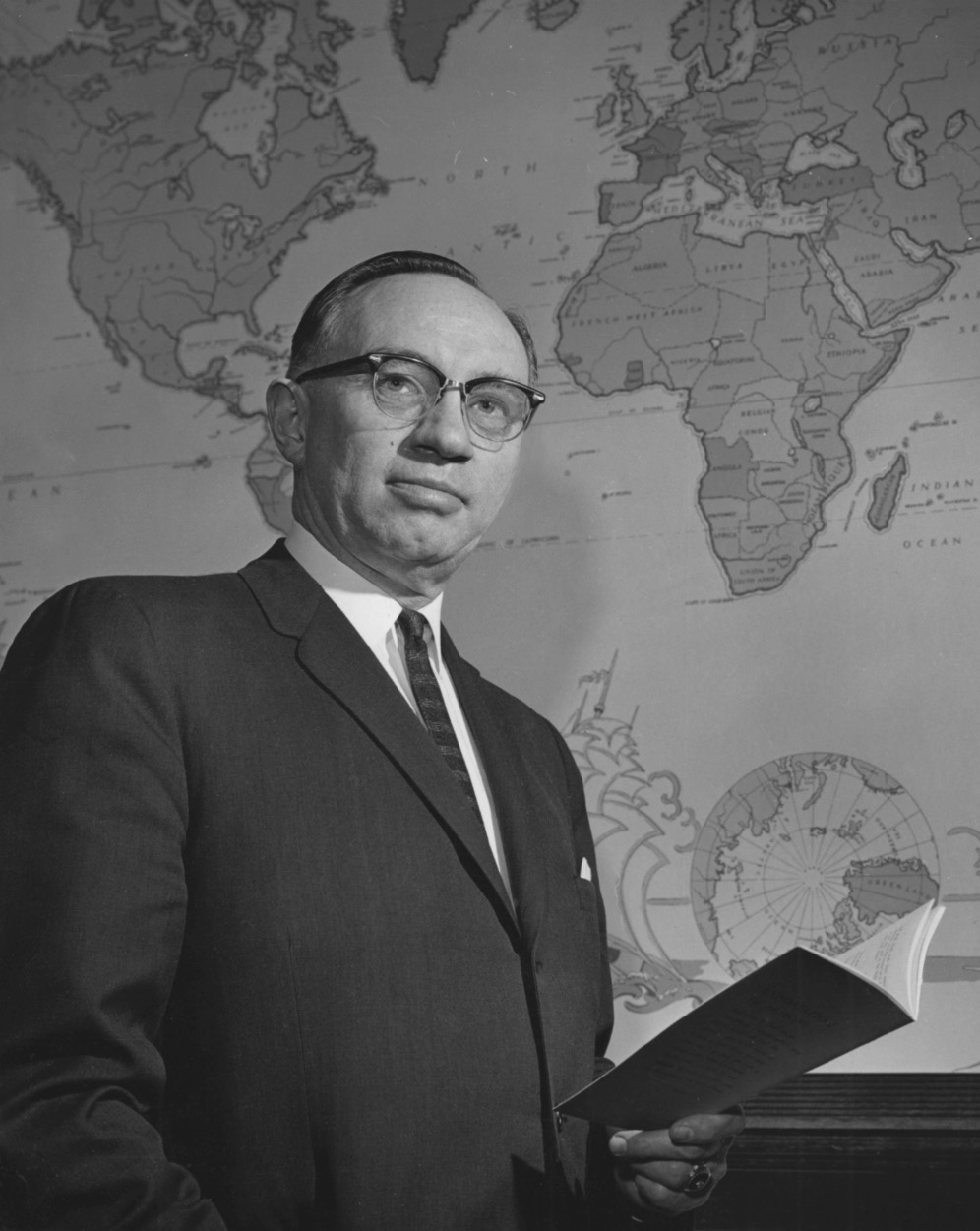 Gordon B. Hinckley. (© Intellectual Reserve, Inc.)
Gordon B. Hinckley. (© Intellectual Reserve, Inc.)
Construction of the Los Angeles Temple was nearly completed when the new method of presenting the endowment using films was first implemented in Switzerland. As built, the temple’s endowment presentation rooms did not include equipment for projecting films, and, with the exception of the creation room, they could not be darkened. Therefore when the temple opened, the new method of presenting the endowment was implemented only partially. Audio recordings presented the endowment instructions. The use of films would not be fully commenced in Los Angeles until January 1958.
A special initial endowment session took place at 11 a.m. on Saturday, April 14, 1956, for temple area stake presidencies and their wives. Also invited were the temple presidency and the California Mission president. Church President David O. McKay, his wife Emma Ray, and two members of the Twelve—Delbert L. Stapley and Richard L. Evans—were present.[18] Gordon B. Hinckley also came from Church headquarters. “The session was very well conducted,” President McKay recorded in his journal that for the first time in the history of the Church the “presentation of the endowment ceremony was given by tape-recording rather than by persons enacting the different parts. It proved conclusively to us that the ceremony can be done very impressively, and that this manner of presentation will probably be used in all the Temples.”[19]
The first regular endowment sessions were on Monday, April 16. President Bowring personally greeted those coming for the opening session that morning. During that same day six couples were married: Leo T. Tovey and Gladys Esther Stewart (Santa Monica Stake), Raymond Vincent Owens and Anna Eda Matinson (Los Angeles Stake), Edward W. Flanagan and Don Lee Larson (Los Angeles Stake), James Oscar Billingsley and Vera Texanna Edmondson (Long Beach Stake), and Lenard Clark Alcorn and Edith Vera Hutchinson (Pasadena Stake). Six other previously married couples were sealed for eternity: Lawrence Leon Downs and Lillian Ruth Fawcett (San Diego Stake); Jesse LeRoy Given and Patricia Elisa Waters (Mt. Rubideaux Stake), Ivan L. McWhorter and Norma Irene Anderson (Long Beach Stake), Kaarman Elmo McBride and Mildred Earleen Wilson (South Los Angeles Stake), and James Albert Sharp and Terrisa Rosalee Murrell (Orange County Stake).[20]
The temple’s original schedule called for four endowment sessions per day, Monday through Friday. There would be a “chapel service” each morning at 8:30, and “Recording of Names” would take place prior to each session, 8:00–9:00 a.m., 1:00–2:00, 4:00–5:00, and 6:00–7:00 p.m. The morning and first evening session would include living endowments and marriages, while the afternoon and second evening session would be for endowments for the dead only. Baptisms and sealings would be by appointment.[21]
Reaching Out to Serve the Saints
From the beginning, there had been a large Hispanic community in Los Angeles. Southern California became even more ethnically diverse during the later decades of the twentieth century with the arrival of people from Asia, Polynesia, and other parts of the world. The Los Angeles Temple took steps to meet the needs of this increasingly diverse population. For the first four years, endowment sessions were only in English. Beginning in 1960, however, other languages became available, including, among others, German (1960), Spanish (1960), Samoan (1962), French (1964), Japanese (1967), Korean (1970), Vietnamese (1975), Tongan (1977), ASL (1978), and Cambodian (1991). Interestingly, the first session in German was offered several months before the first session in Spanish. A local stake had organized a group to help German immigrants adjust to a new language and culture; they appreciated being able to receive temple ordinances in their native tongue.[22] Other languages followed, reflecting the changing Southern California population. For example, on March 21, 1962, the first endowment session in Samoan was held. Among the more than forty-five who attended was a ninety-year-old Samoan chief, Savea Aupiu, whom President Bowring had known in Hawaii. Although he did not know any English, he had faithfully attended the temple there. Having moved to Los Angeles, he was now grateful to hear the presentation in his own language.[23] Samoan and Tongan groups often arrived at the temple early and sang hymns as they waited for their session, filling the chapel with the beautiful harmony for which Polynesians are noted. Beginning in 1977, patrons could attend English sessions and hear the endowment in other languages by means of earphones. As the international membership of The Church of Jesus Christ of Latter-day Saints grew at an accelerated pace and as additional translations were made, the number of languages available in the temple multiplied.
Sometimes the temple needed to make arrangements to accommodate speakers of other languages into which the ordinances had not yet been translated. For example, in 2010 Rashida Khushi, who spoke Urdu, came from Pakistan to receive her endowment. Her brother, a returned missionary, would translate for her. After she received her initiatory ordinances, she went to the temple president’s office where her brother translated as President Grant Brimhall reviewed the content of those blessings and Sister Avis Brimhall gave comments and instructions. Rashida’s brother then sat with her and translated throughout the endowment experience. She then returned to her homeland as an endowed member ready to serve in her small branch.
Those who were deaf or hearing-impaired constituted yet another group served by the Los Angeles Temple. The Church convened a conference in 1972 to consider ways to better meet the needs of these members. A new film showed how priesthood ordinances could be performed without speech. A new dictionary was compiled to standardize signs used to interpret unique Church-related terms in American Sign Language (ASL) for the deaf. At the heart of this effort was a group at the LDS Institute of Religion located at Cal State Northridge, so when it came to working out temple-related signs, they naturally reached out to the nearby Los Angeles Temple. Under the direction of the Presiding Bishopric, representatives from several temples met in June 1978 for this purpose. In the fall of that year, deaf patrons were able for the first time to perform sealings, with Wayne F. MacIntire, a temple sealer familiar with ASL, officiating. Eventually the deaf could watch the endowment film and see on a small screen a man dressed in white interpreting in ASL.
In order for the temple to serve Church members, they personally needed to come to it. Over the years, therefore, there have been a variety of efforts to increase attendance at the temple. Originally only twenty endowment sessions were scheduled per week. In later years, this number was increased, including offering sessions on Saturdays beginning early in 1957. The total reached seventy-six sessions per week in 1978. Early sessions were also added on certain mornings so patrons could come before going to work. Because many had to travel long distances and transportation was expensive, the schedule of endowment sessions was adjusted so patrons could conveniently participate in two or more sessions during a single visit to the temple. Church leaders eventually directed that quotas not be assigned to stakes, wards, or individuals, but temple anniversaries or other special occasions were sometimes used to encourage attendance.
Just as Southern California Saints had traveled to temples in Utah or Arizona in earlier decades, Church members from distant areas now came to Los Angeles. Before the Oakland Temple was dedicated in 1964, stakes in northern California and even Oregon chartered buses and organized excursions to the Los Angeles Temple. This undoubtedly contributed to the decision to add Saturday sessions. The Sacramento Stake outlined a plan to send a busload of different groups to meet the stake’s commitment to have 2 percent of stake membership in the temple each month. A group of 102 members of the Klammath Stake in southern Oregon traveled 1,400 miles round trip to spend two days in the temple. The adults attended three sessions each day, performing four hundred endowments, while the youth spent four hours performing baptisms for the dead. On a later excursion from this same stake, the Relief Society in the Redding Ward of northern California provided breakfast for the group en route to the temple. In yet another excursion from Klammath Falls, 181 members in fifty-four private automobiles, one bus, and one airplane logged a total of 86,400 miles to reach the temple where they performed 1,122 endowments. Seven couples and eighteen children were sealed for eternity.[24] Groups of servicemen in basic training at Fort Ord also came to the temple.[25]
Some excursions were designed especially for the youth. A bus brought fourteen boys, nineteen girls, and seven adult leaders from the San Mateo Stake; they performed six hundred baptisms. The youth worked to cover their own expenses. At fast meetings back home the following day, testimonies from the youth showed they had appreciated this experience. Six buses brought 223 youth from the Columbia River Stake to the temple; they also paid their own expenses and had done the research to identify the two thousand persons for whom they performed baptisms. The Burbank Stake provided housing for the group while at the temple and allowed them to use their chapel for a testimony meeting. The youth visited points of interest in Southern California before the twenty-four-hour bus trip home.[26]
These temple excursions also played a key role in programs to help those who had been less active. Fourteen “senior members of the Aaronic Priesthood” (later called prospective elders) and fourteen sisters from San Luis Obispo came to the temple to perform baptisms. A similar group in the Concord Ward made an even loftier achievement. “Their goal was not a certificate of completion when the course was concluded, but qualification of each husband and wife and their children to enter the temple for sealings.” Eight formerly less active couples in Redondo Beach also achieved this same goal. Thirty-five couples from the Orange County Stake completed the “Project Temple” course and were sealed in the Los Angeles Temple.[27]
Before the 1993 dedication of the San Diego Temple, the Los Angeles Temple’s capacity to present temple ordinances in Spanish attracted groups from south of the border where Latter-day Saint membership was exploding but where there were not yet any temples. For example, in October 1974, a group of twenty-four adults and ten children who had come by bus from Guatemala spent three days at the temple. Eleven couples were sealed, and the ten children were sealed to their parents for eternity. In May 1985 a group of 150 Saints came in three buses from Tijuana. Fourteen received their own endowment, five couples were sealed, and eighteen living children were sealed to their parents. The temple recorder, Ego A. Gabasa, was able to work with these and other similar groups in Spanish. These Hispanic Saints were grateful for the privilege of having this special temple experience in their own language.
In later decades, the Los Angeles Temple served the increasing number of refugees who had fled wartime conditions in Southeast Asia. On July 5, 1986, more than a hundred of these refugees received their temple ordinances. Missionaries and previously endowed members who knew Hmong and Laotian translated for members from branches in Fresno and San Diego. Members of the Los Angeles Chinese branch provided food. In addition to the scores of living children, thirty-one children who had died during the war and its aftermath were sealed to their parents. Temple workers reported feeling “a rich outpouring of love and an almost overwhelming feeling of peace.” Among the Hmongs participating were members of the Kacha Moua family, who had fled persecution in their homeland. Before reaching America five of their eleven children had died. All were sealed as a family. The parents reported that “they could feel the Spirit touching them” as they were sealed to their children. Sister Moua gratefully acknowledged, “We are glad that we will be together in heaven.”[28] Still, temple leaders were worried that the ordinances might not be presented correctly in languages with which they were not familiar and no official translations had yet been provided.
Because for many years far fewer women than men were in the labor force, there was an imbalance in temple activity. Many women were available to attend the temple during the day, while most men could come only after work. Year after year, the number of ordinances performed by the women far exceeded the number of those done by the men. To help correct this, special priesthood endowment sessions were scheduled. It was a unique experience to be in the room filled almost entirely with men. For the temple’s first quarter century, special priesthood days were scheduled on designated Saturdays two or three times during each year. On October 4, 1956, for example, men from throughout California had in some cases driven through the night to reach the temple. By 10:00 a.m., there were 1,507 faithful men present. That day, they performed a total of 2,946 endowments for males, which President Bowring believed was a record for a single day. (This was the same day as general conference in Salt Lake City, but proceedings were not widely broadcast in California at this time.) Even more was accomplished on a similar priesthood day on October 30, 1964. Sessions were scheduled every forty-five minutes from 6:00 a.m. through 8:15 p.m., for a total of twenty sessions; 4,013 male endowments were performed on that day. With so many sessions during the day, men could catch up somewhat in their temple work.[29]
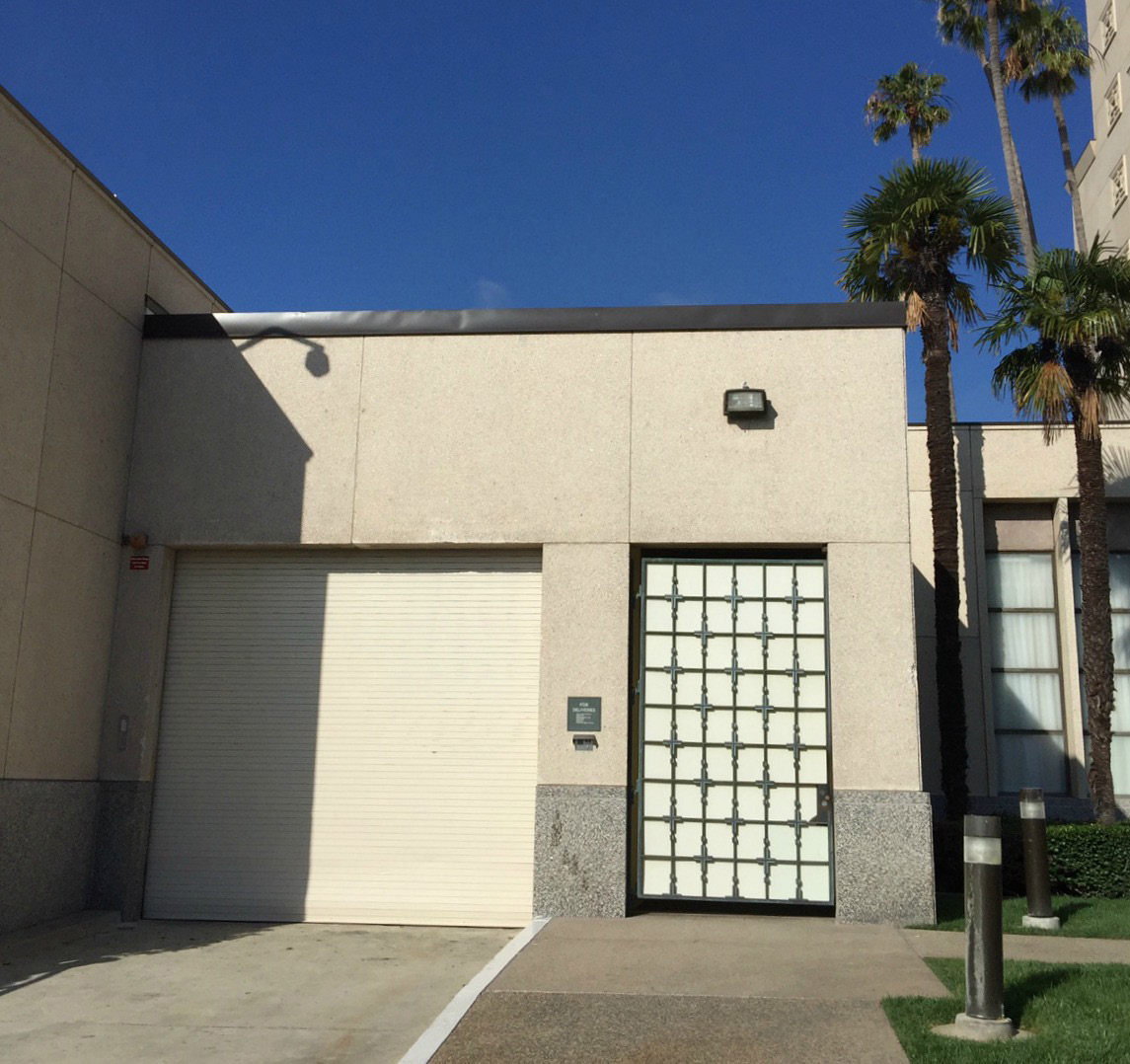 The temple entrance near the cafeteria on the east wing. (Linda Gerber)
The temple entrance near the cafeteria on the east wing. (Linda Gerber)
Solemn assemblies for priesthood leaders were a special category of meetings held in the temple. The first of these convened on Sunday, June 9, 1957. Some 2,600 stake and ward leaders, all holding the Melchizedek Priesthood, attended the four-hour session in the temple’s third-floor assembly room. All the General Authorities (except one who was ill) were present. They came in three chartered Union Pacific railway cars and were met at the suburban East Los Angeles station. There a caravan of nine automobiles with police escort drove them across the city to the temple. Afterward, those enjoying the spiritual impact of this special occasion were saddened when they learned that four leaders from Chico in northern California were killed in an airplane crash on their way home.[30]
The level of activity at the Los Angeles Temple generally increased through the 1980s. After that time various factors caused it to level off or even decline. The rapid rate of Latter-day Saint growth in Southern California during earlier years was not equaled during the closing decades of the twentieth century. Demographic shifts resulted in many members moving from some areas within the Los Angeles Temple District. Construction of other temples reduced the size of this temple district. The dedication of temples in Oakland (1964), Fresno (2000), and Sacramento (2006) had a smaller impact than did the dedication of closer temples in San Diego (1993), Redlands (2003), and Newport Beach (2005). The Los Angeles Temple was called on to help train personnel for these new temples in addition to losing faithful workers who lived in the districts of these newer temples.
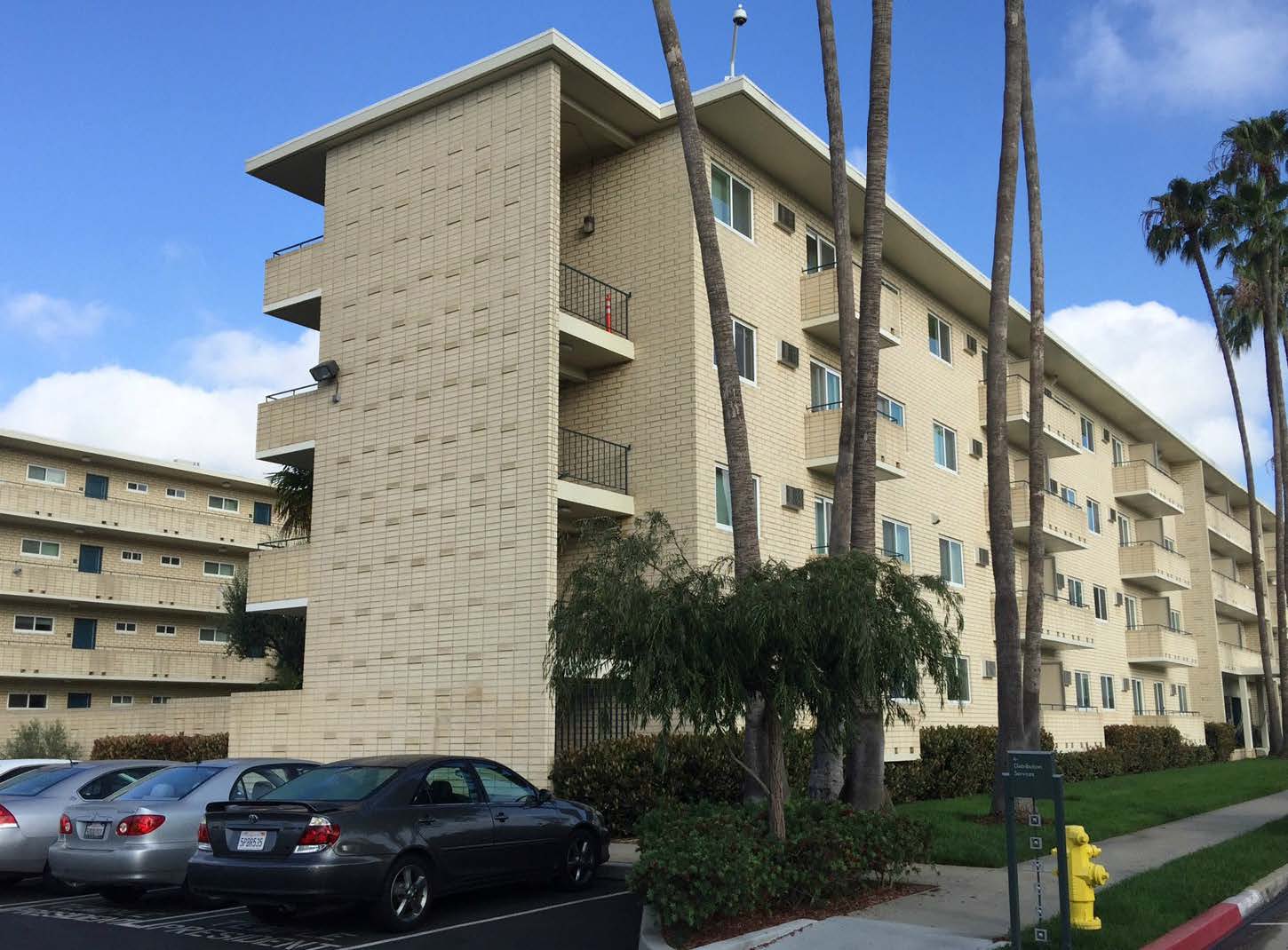 The patron apartments. (Linda Gerber)
The patron apartments. (Linda Gerber)
Developments in Physical Facilities
As the temple went into operation, ways were discovered to enable the building to more adequately fulfill its sacred functions. Some of these were for practical convenience, such as transferring the laundry in 1958 from the heating plant to the temple’s basement. Another change benefitted temple patrons. Because most of them parked along the east roadway or in the lot behind the bureau of information, they had to walk around the cafeteria wing at the southeast in order to reach the temple’s front entrance. To avoid this long walk, a side entrance just north of the cafeteria was made available. In 1958 it was covered by an entrance shelter. It saved steps, but the approach next to the cafeteria’s service driveway was not as attractive as the front entrance. When a new parking lot was opened west of the temple in 1972, this east side entrance lost its advantage. Hence in the following year, the large bronze doors by the reflecting pool once again became the temple’s main entrance. Ramps were constructed at the side of the stairs to help patrons using wheelchairs.
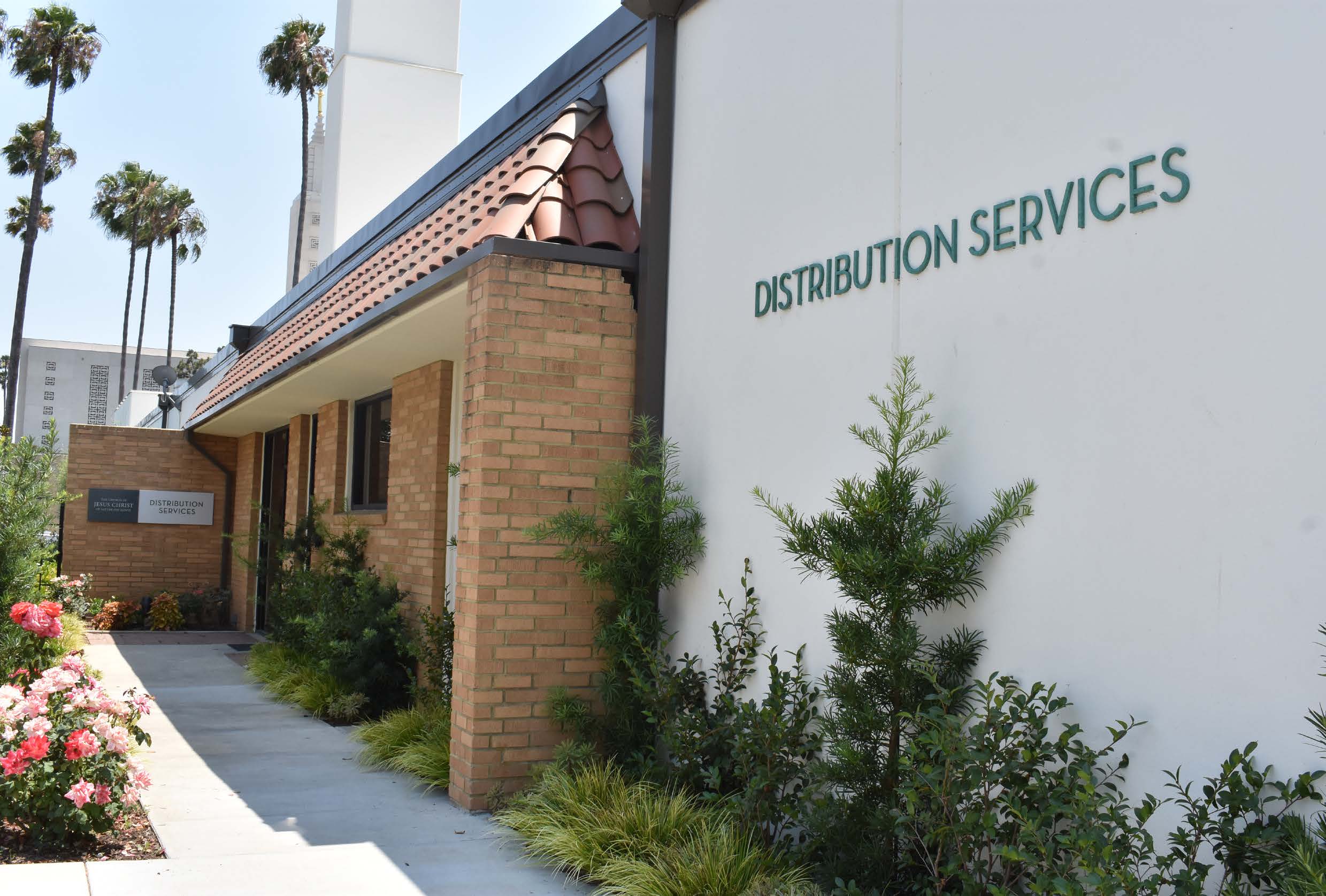 The distribution center next to the utilities building. (Katie Hendrickson)
The distribution center next to the utilities building. (Katie Hendrickson)
Especially during the early decades after the dedication of the Los Angeles Temple, some California Saints had to travel long distances. Two years after the temple’s dedication, the temple advisory committee recommended that the Church provide housing on site specifically for temple workers. Construction started in 1964 on the $1,247,000 project. The contractor was Miles H. Indermill and Wm. Steiskal, Inc. The complex featured an “interesting arrangement” of six four-story buildings situated around three “spacious patios” and was located behind the temple on a nicely landscaped plot measuring 280 by 130 feet. The building’s light brick exterior matched the temple’s color scheme. The 102 temple patrons apartments were opened early in 1966.[31] Those planning extended work at the temple were especially encouraged to use this housing in order to cut down on travel and to save time. After the apartments opened, temple workers coming from the most distant areas typically served for a full week each month rather than coming on a certain day each week.
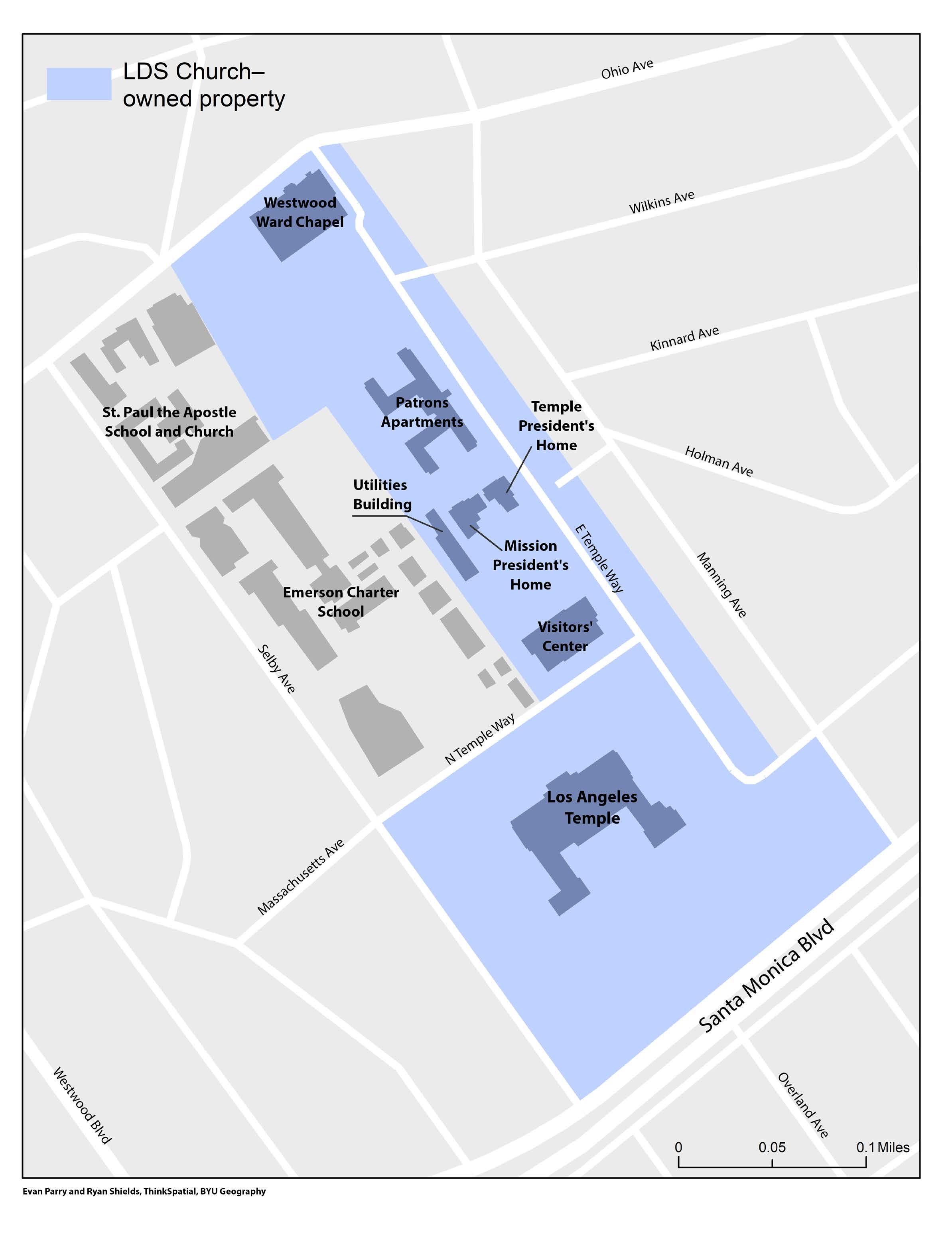
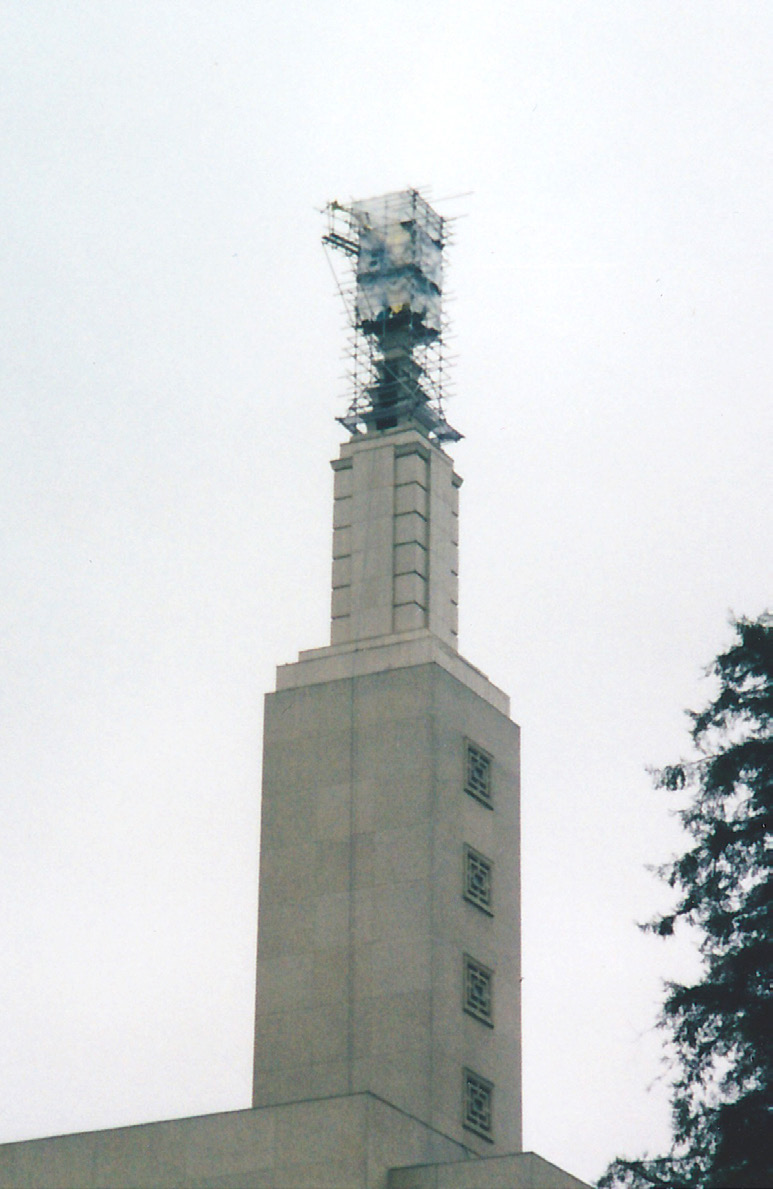 Preparations for the regilding of Angel Moroni. (Courtesy of Harvey Freind)
Preparations for the regilding of Angel Moroni. (Courtesy of Harvey Freind)
During the 1970s several improvements were made inside the temple. A new brides’ area was created adjacent to the sisters’ dressing room. Additional sealing rooms were provided. A priesthood room for workers’ meetings was opened in the temple’s basement.
A more substantial reconstruction at the beginning of the next decade expanded the temple’s capacity. By 1980 the level of patronage was double that of the 1950s. Early in 1981, therefore, the temple was closed for ten weeks for remodeling. The creation, garden, and world rooms became known as ordinance rooms 1, 2, and 3, respectively. The terrestrial room was divided, the rear half becoming a fourth ordinance room. The front portion of the former terrestrial room became the place where patrons from all four ordinance rooms would complete their endowment experience. This remodeling enabled a new endowment session to begin every half hour. With the use of films, groups would receive the entire endowment presentation in a single room rather than progressing from room to room. Previously, new sessions had started only every hour, so this change approximately doubled the temple’s capacity. Other changes made during the closure included new carpeting and seating, improvements in air conditioning and audiovisual equipment, as well as roadwork and new ornamental gates outside on the grounds. To inaugurate these improvements and to commemorate the temple’s twenty-fifth anniversary, it remained open from Friday morning, March 20, through the night to Saturday evening, March 21, 1981, with sessions being offered continuously around-the-clock for thirty-six consecutive hours.[32]
On this occasion Elder S. Dilworth Young wrote another of his poems about the Los Angeles Temple.
The Los Angeles Temple—A Quarter Century Long
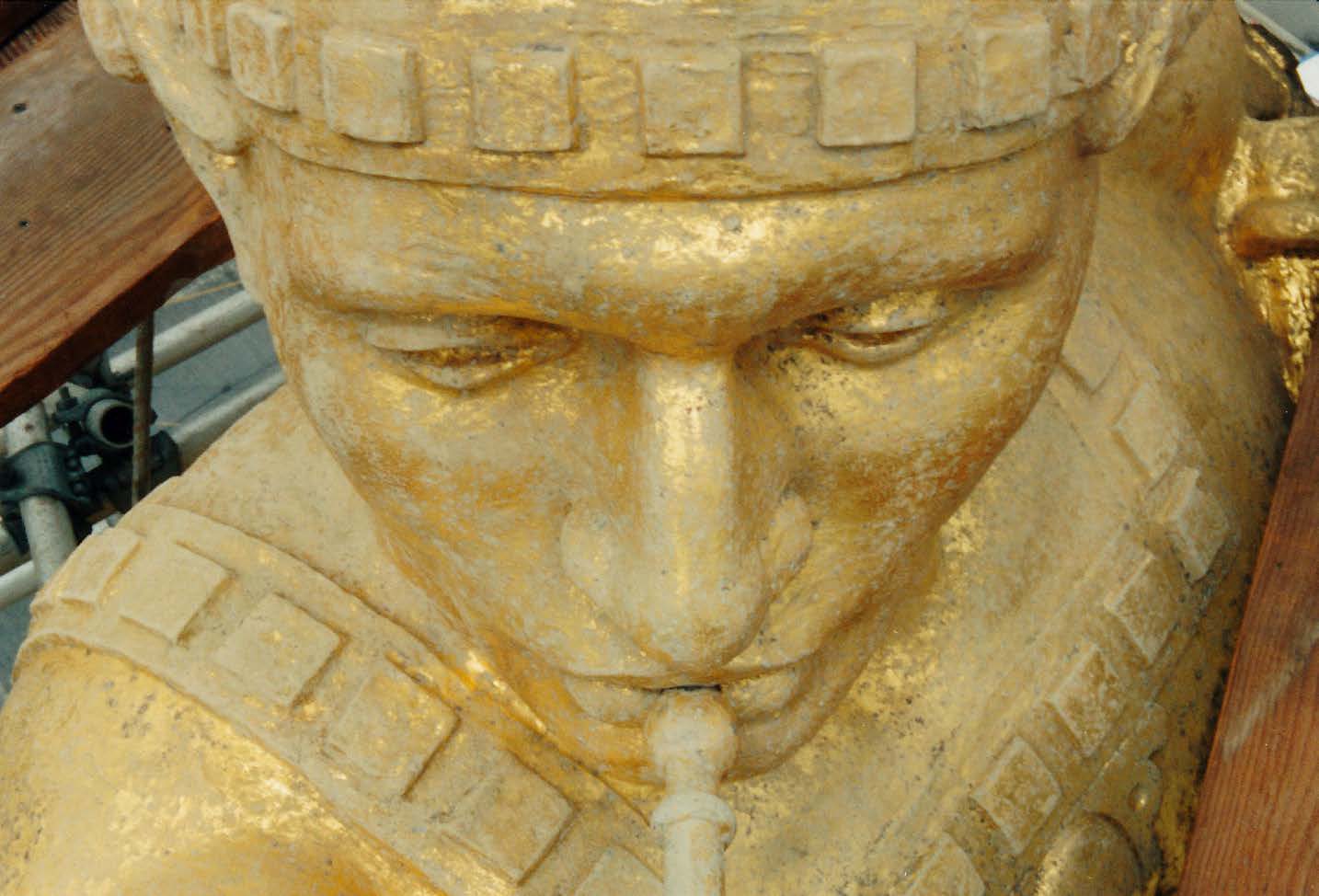
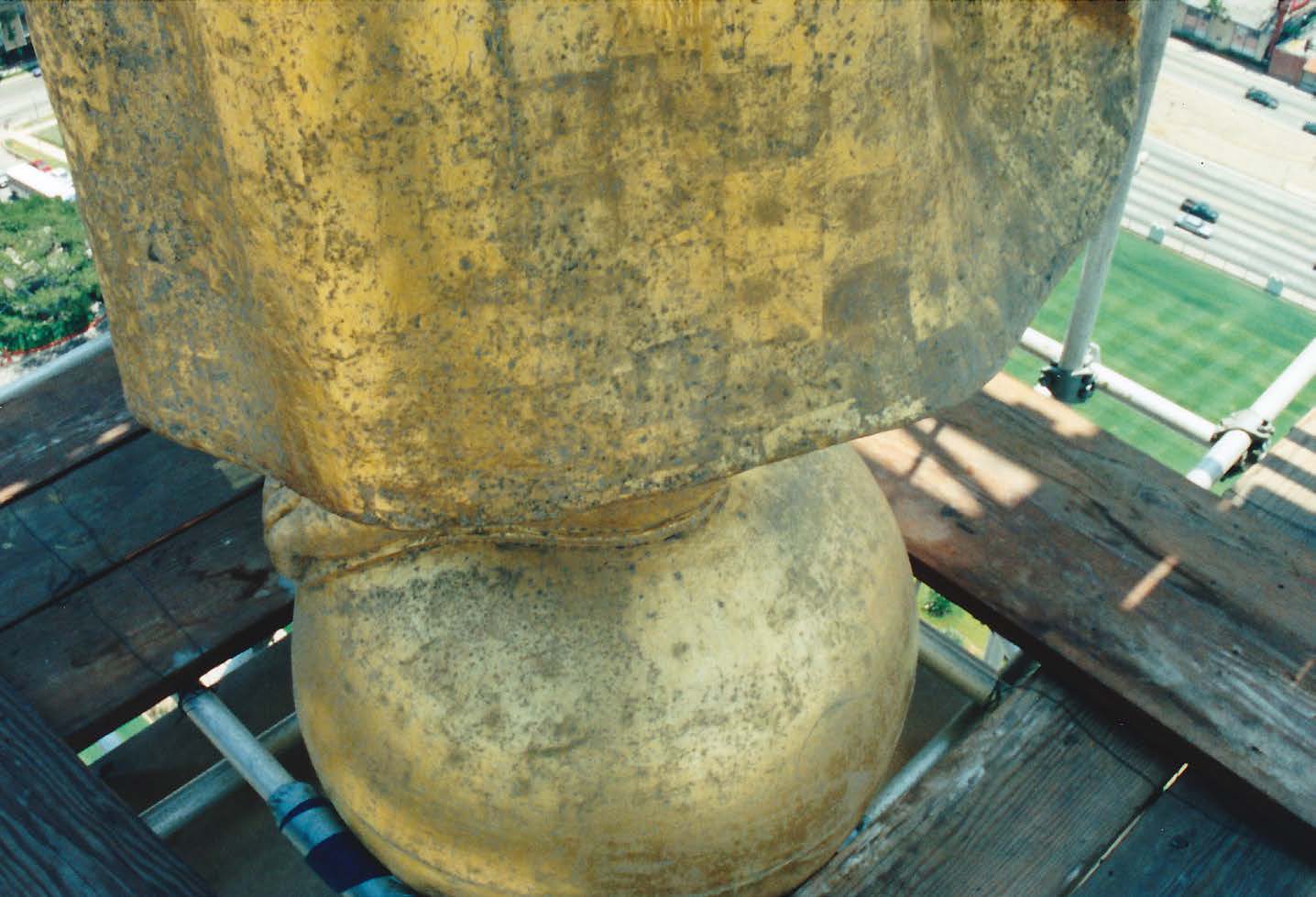 Regilding, August 1998.
Regilding, August 1998.
(Courtesy of Harvey Freind)
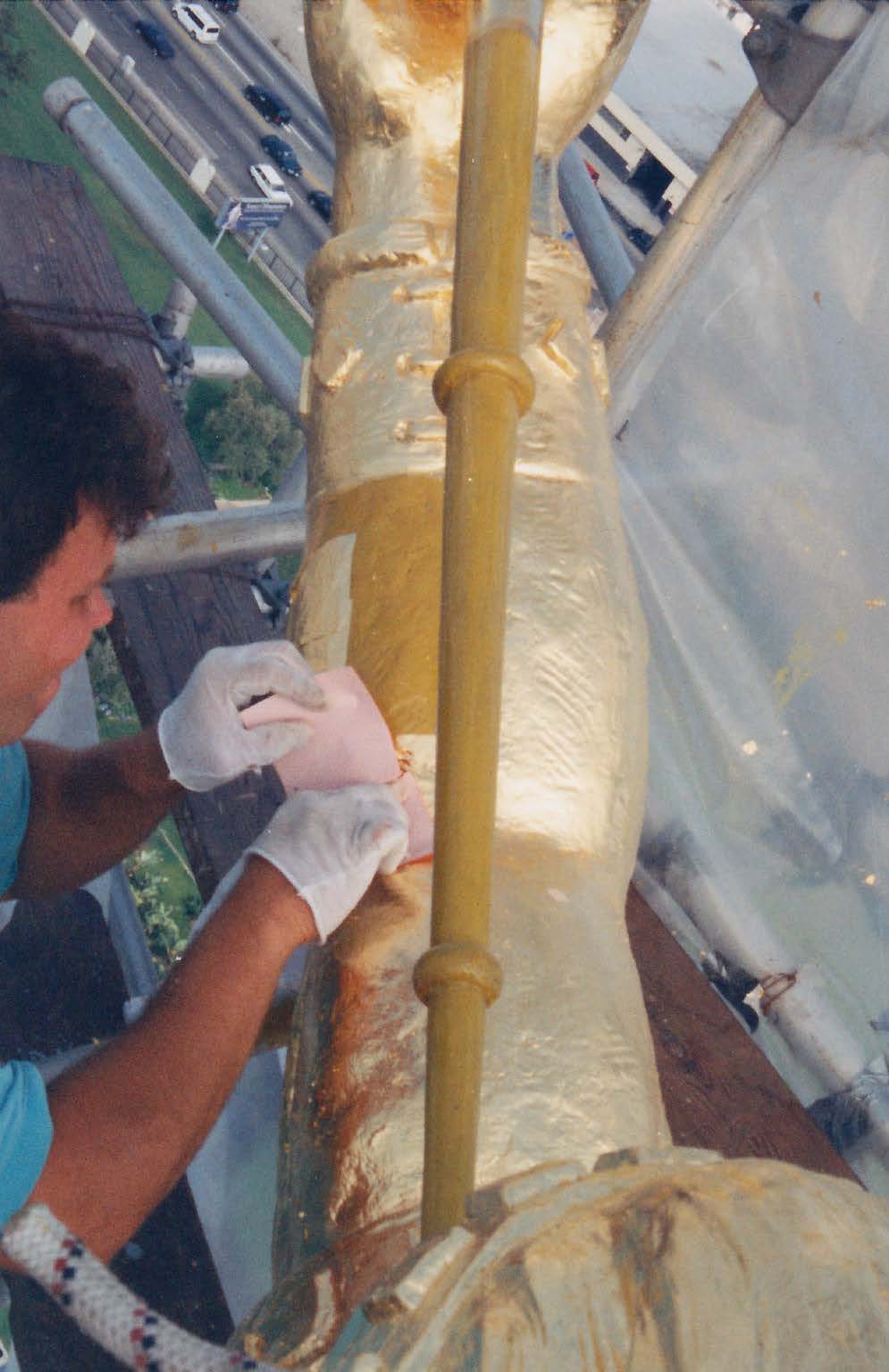
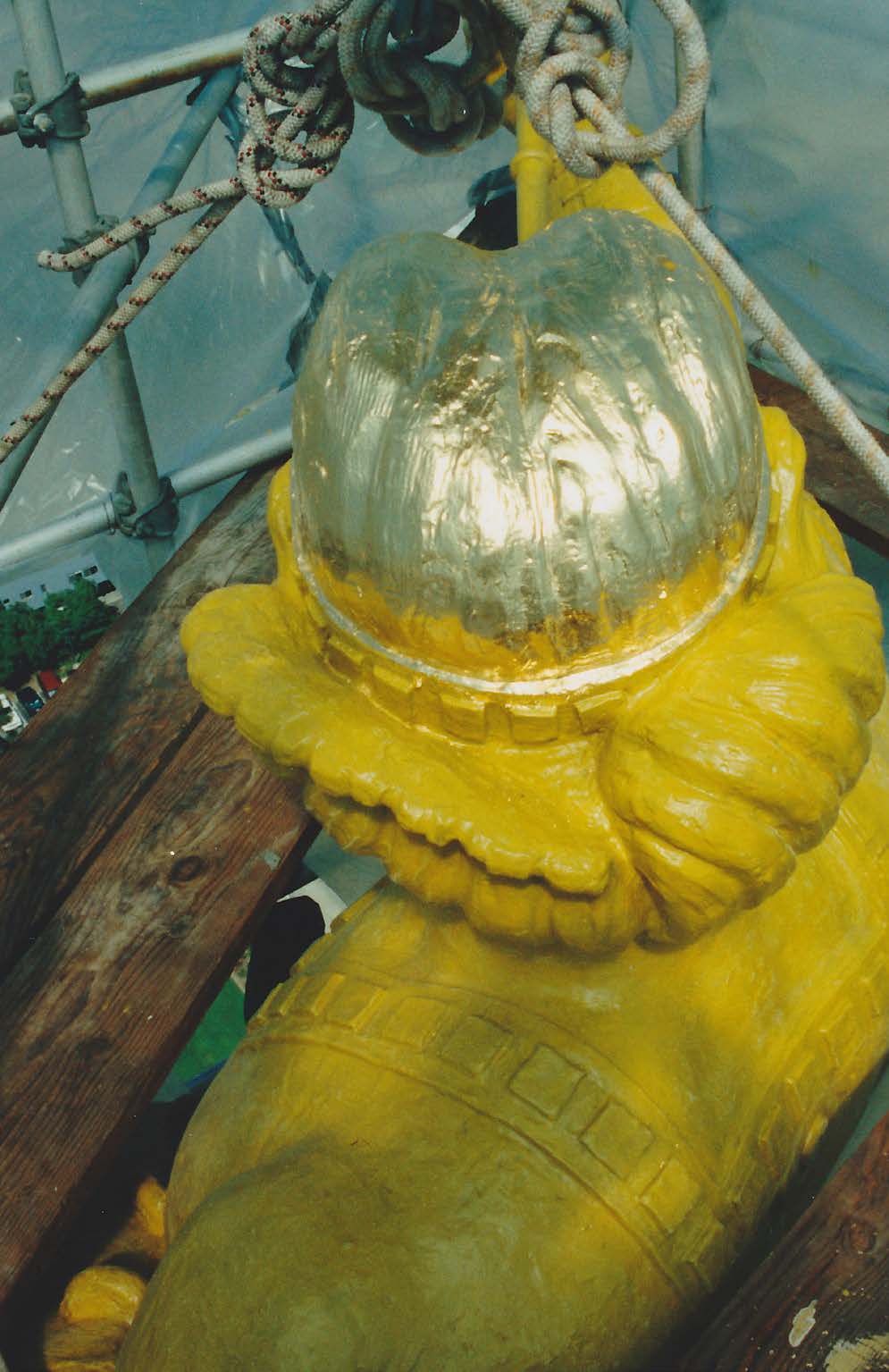
Here stands the Temple, strong and firm,
Its spire a landmark
To the country round.
Its angel trumpeting
In silent sound the news
That Christ the Lord
Has come again.
It stands
A quarter century long
And strong
As an eternity.
And in that time
Nine Thousand days have passed
While anxious spirits
Waited
At the portals of the veil
To hail those who in their behalf
Spoke words which granted liberty.
Time, not measured in eternity,
Unmarked by hours or days,
Seems endless
To those waiting there.
How many have been freed
The torturous wait?
Six million of the teeming hosts
Of heaven have been freed.
Six million—if they
Accept the work here done—
Are started on their way
To claim what for them
Christ has won.
And still
A hundred-million more await
The work which we can do,
To save and unite souls
In family bonds eternal
And secure.
Let us stand true![33]
In 1982, another step was taken to improve the temple’s exterior appearance. In March of that year, after nearly three decades of exposure to the elements—including Los Angeles’ infamous smog—time had come to regild the figure of Moroni high atop the temple’s 250-foot tower. Scaffolding, which had been stored in the tower, once again was set up around the angel. The work was done under the direction of a master craftsman, Henning Anderson of Salt Lake City. A native of Denmark, he received his master of arts degree from the Royal Academy in Copenhagen. His masterful touch can be seen in several castles in Europe and in most of the temples in the Church. Preparing the statue was a time-consuming process. It had to be stripped with a wire brush and sandpaper and then thoroughly wiped clean. An anti-mildew solution was applied to counter the harmful effects of humidity in the prevailing sea breezes. Special adhesive was next brushed on to help the 3 3/
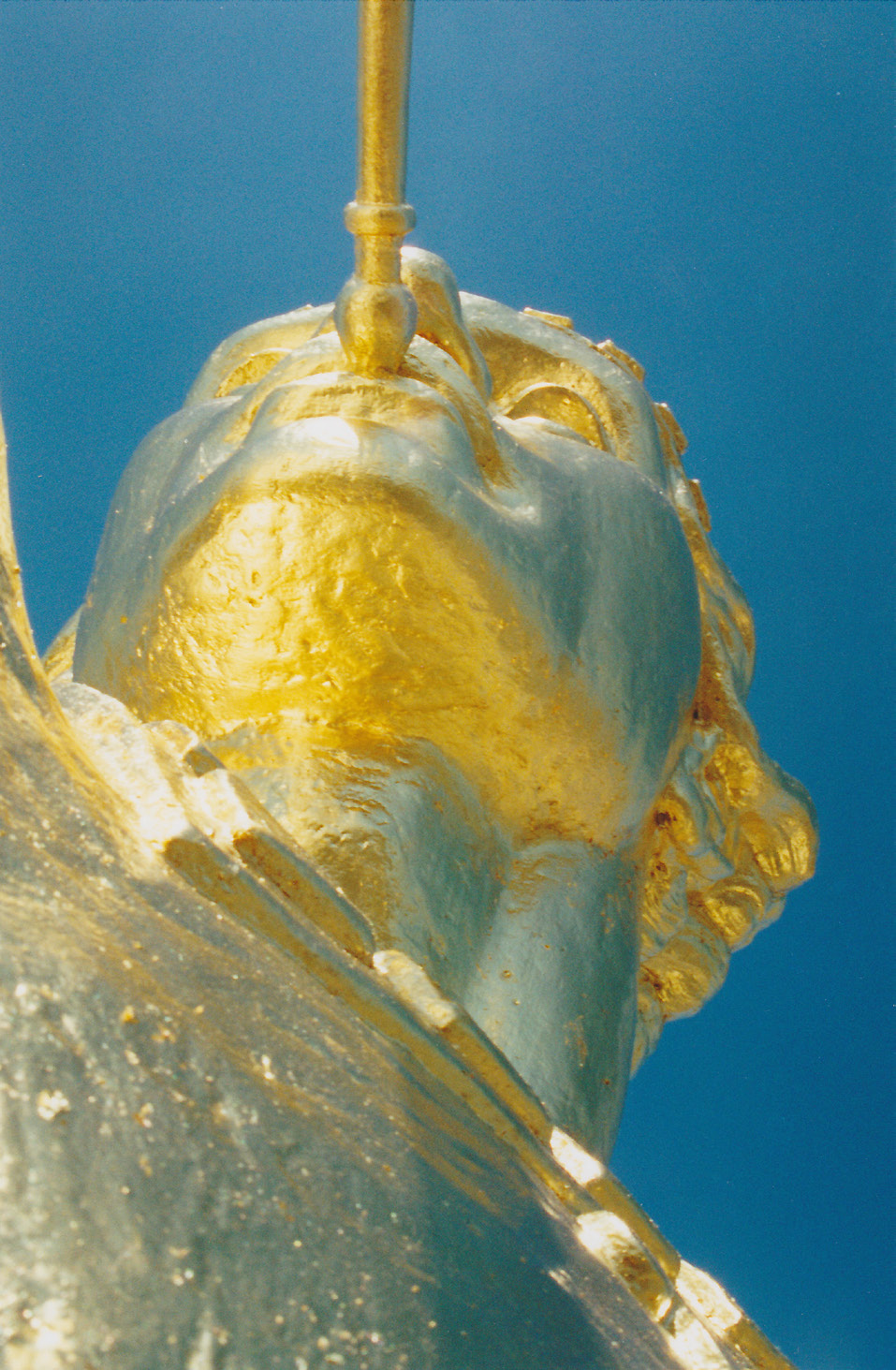
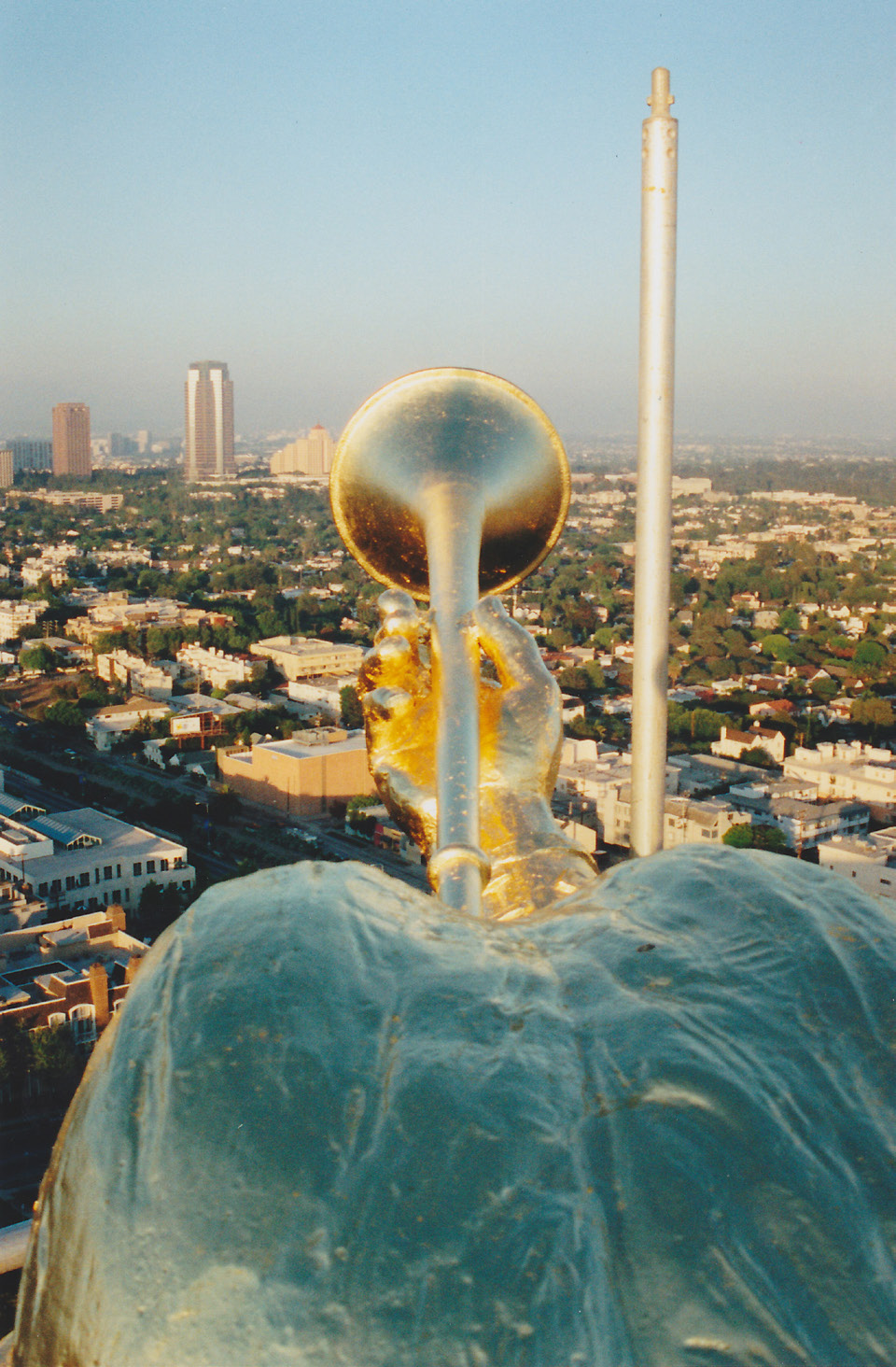
In 1985, the coming of computers to the temple had an impact on space needed for several functions. The computers not only recorded ordinances more efficiently, but they also ended the need to provide room for a group of secretaries who used typewriters to issue proxy name slips to temple patrons.[35]
Just under a decade later, a natural disaster affected the temple. At 4:30 a.m. on Tuesday morning, January 17, 1994, Southern California was hit by the 6.7 Northridge Earthquake. The death toll was 57, and more than 8,700 were injured. Damage reached into the billions, notably to the extensive freeway system so important in the life of the region. A bridge collapsed on the Golden State Freeway in the Newhall area, but the greatest impact was damage to the Santa Monica Freeway or Interstate 10, which passes near the Los Angeles Temple. Because it is one of the busiest highways in the nation, its three-month closure for repairs caused a major problem for commuters. There was a temporary drop in temple attendance following the earthquake, but this soon recovered. At the temple, four windows on the third floor and some crystal lamps were broken. An inspection revealed that there was some stress to the tower’s steel structure, but there was no immediate concern. Still, the tower’s framework was later strengthened.[36]
Toward the Half-Century Mark
Over the years, the number of stakes in the Los Angeles Temple district had increased. By the early 1990s, the total reached nearly one hundred. When the San Diego Temple was dedicated in 1993, twenty-one stakes were reassigned, and three more were transferred to Fresno in 2000. The April 2001 announcement of new temples at Redlands and Newport Beach indicated that the Los Angeles Temple’s district would be reduced even further. Sixteen stakes would go to Redlands in 2003, and eleven more to Newport Beach in 2005. These changes took pressure off the Los Angeles Temple. Furthermore, population shifts to more outlying areas resulted in the consolidation of some stakes. Hence, by the time of the Los Angeles Temple’s fiftieth anniversary in 2006, its district had only forty-three stakes. This reduction of pressure on the temple meant that improvements could be made even though they might reduce the temple’s capacity.
In the latter part of 2002 the temple was closed twelve weeks for another extensive remodeling. Those associated with this significant project felt the definite presence of divine help. The original terrestrial room was restored by removing the wall which had divided it. The plan called for two large alabaster chandeliers in this spacious room. Because this translucent material was mined in Spain, there generally was a delay of several months in obtaining it. The builders therefore feared the chandeliers would not be available in time for the temple’s anticipated fall reopening but rather would need to be installed during the Christmas break or even later on. As things worked out, they were available immediately. Two years earlier, the Church had ordered one of these chandeliers for the Perth Australia Temple, and the manufacturer had decided to produce three instead of just the one that had been ordered. Therefore the supplier already had the two needed for Los Angeles. They were shipped right away and were in place when the temple reopened in November.
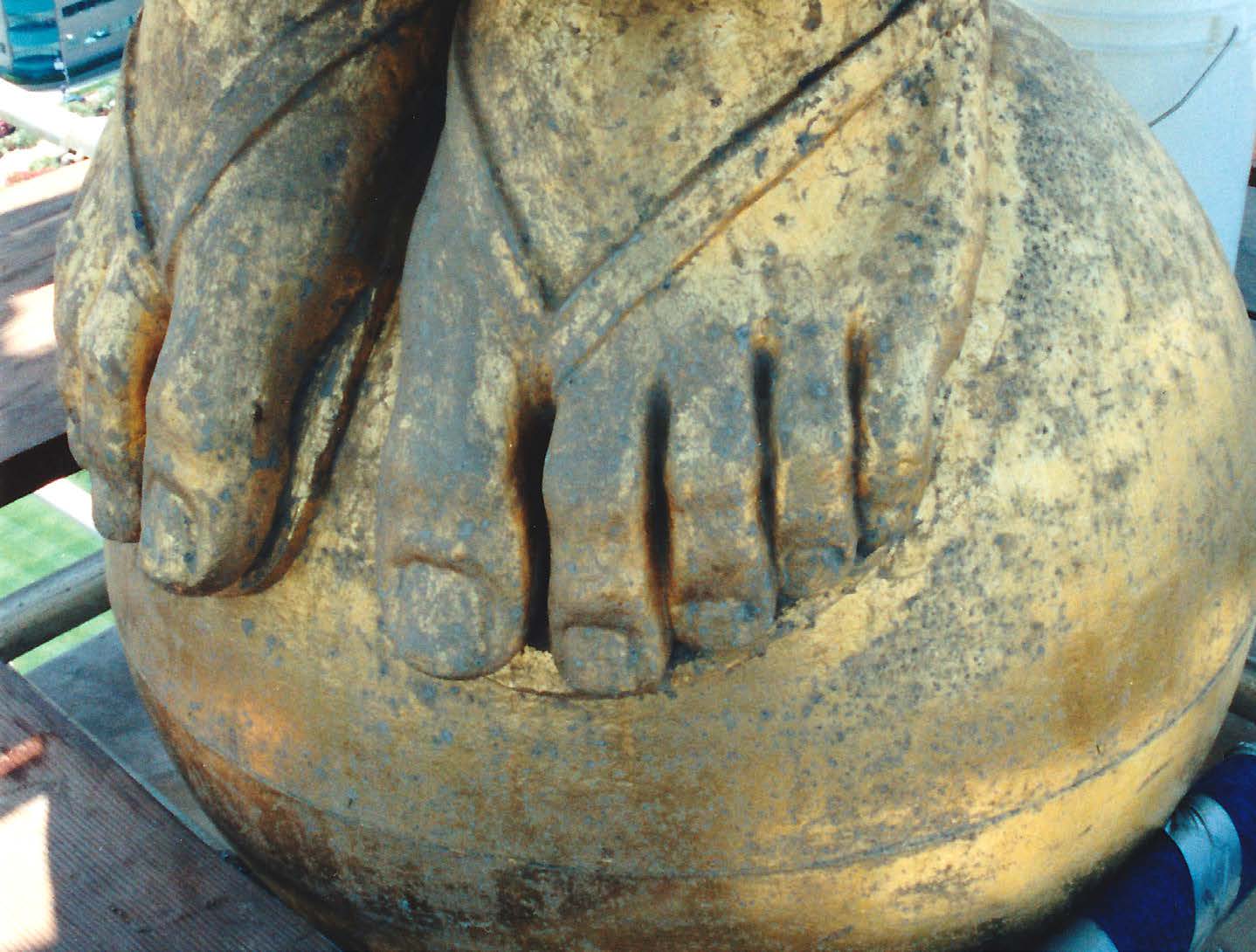
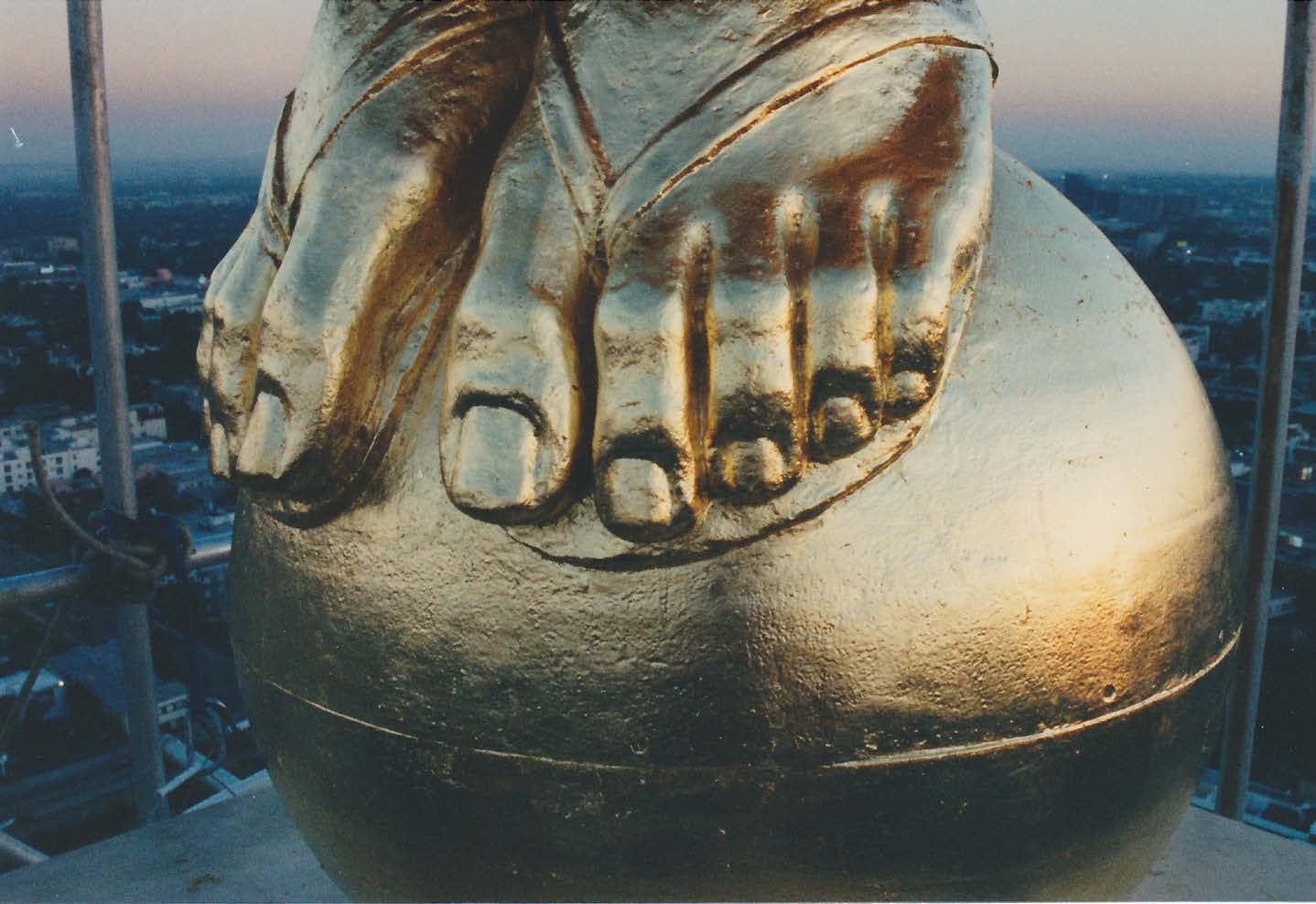 Before and after regilding.
Before and after regilding.
(Courtesy of Harvey Freind)
Once again, patrons would receive the endowment by passing through the series of large rooms with murals depicting the creation, garden of Eden, and the present world. Sessions could begin only every forty-five minutes rather than every half hour, but this would eliminate the need for patrons to stand in the hall waiting for their turn to complete the endowment experience before passing into the celestial room. Furthermore, the capacity in some of the large rooms was reduced from the original 300 seats to about 260 so ramps could be added over the stairs where needed to help those using wheelchairs. In announcing these changes, the Area Presidency affirmed: “The magnificent ordinance rooms of the Los Angeles California Temple are a sacred treasure of the Church. Soon everyone will be able to see all of the rooms every time he comes to the temple. This restoration will enhance the spiritual learning of all who participate in the ordinances of the temple and help them to gain a greater appreciation of the holy endowment.”[37]
The temple closed once again from November 2005 to July 2006 for a thorough renovation and seismic retrofitting. A crossbeam in the tower that had been bent by the 1994 earthquake was repaired. The temple’s electrical and ventilation systems were redone. New carpeting was installed in the main floor halls and in the cafeteria area. Facilities in the baptistry were extensively rearranged. Even though the building was in shambles during these renovations, temple president Richard Andrus observed that its spirit could still be felt and touched those working on this involved project.[38] Construction workers from Utah were housed in the patron apartments, and they received their noon meal in the temple cafeteria. The temple engineering staff helped identify the location of various mechanical systems. The clerical staff used the downtime to review and clean out old records. Dust from all the construction projects required the white clothing in the baptistry and youth center be washed thoroughly before the temple reopened. All these arrangements cut costs significantly and made it possible for temple employees to keep working without interruption.
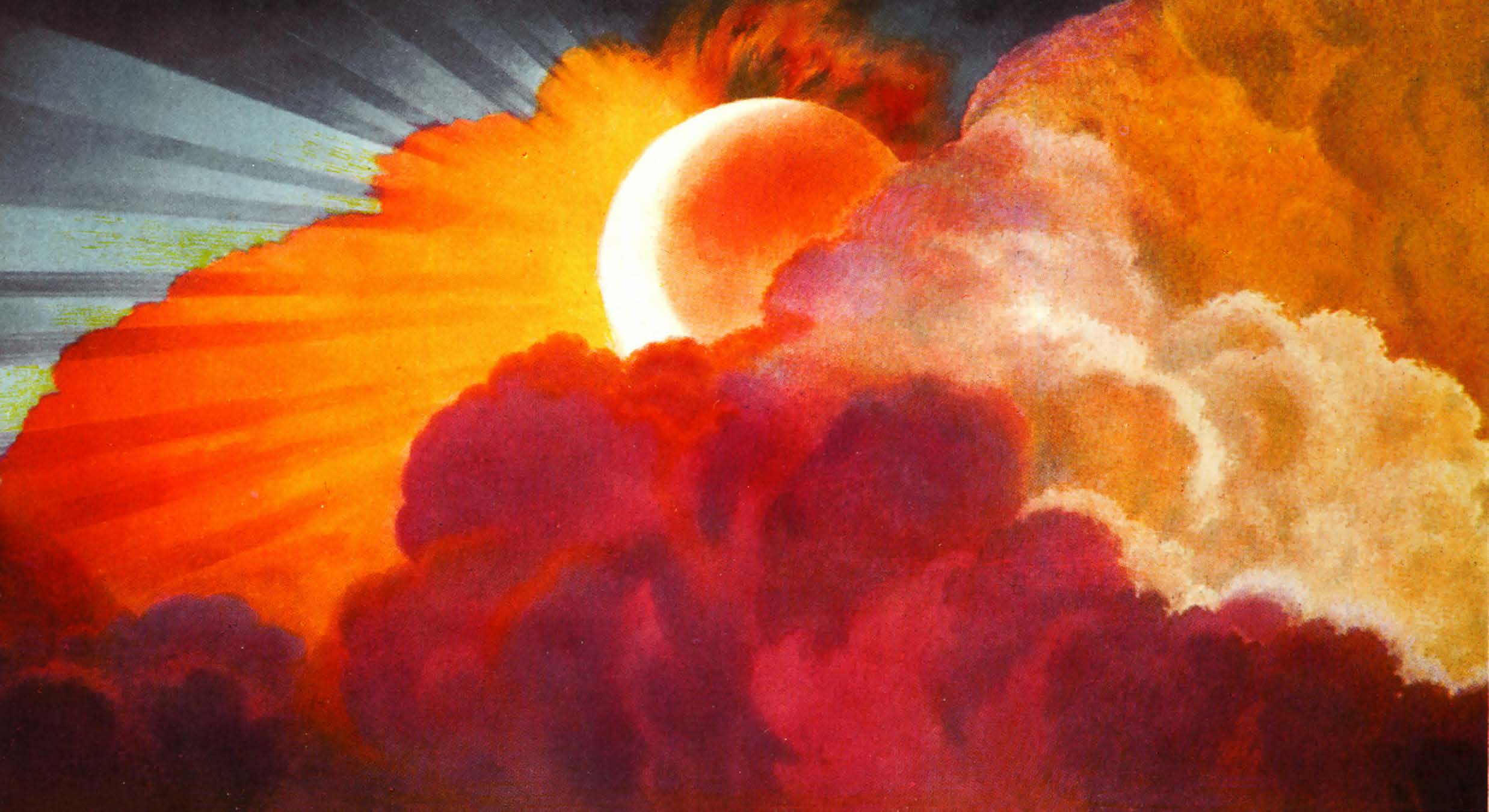 Murals from the creation room. (© Intellectual Reserve, Inc.)
Murals from the creation room. (© Intellectual Reserve, Inc.)
What were regarded as miraculous circumstances accompanied two of the major aspects of this renovation. The 34-foot-high ceiling of the large third-floor assembly hall needed to be replaced. Structural elements of the scaffolding which would fill the room could be brought up the stairways from the outside, but the planks on which the workmen would stand needed to be lifted by a crane and then passed through a window. A special kind of plaster was required, available through only one supplier in the Los Angeles area. Temple contractors bought the supplier’s entire inventory. As the massive project neared completion, the contractors discovered they would not have quite enough plaster to finish. They went back to the supplier, who reminded them that they had already bought his entire supply; nevertheless, he made a more thorough search and discovered one more flat of plaster—just enough to finish the job. Long drapes for the large ordinance rooms could be produced only by a company with cutting tables big enough to do the job. Barge Christensen, who worked on drapes for the temple, contacted a company that produced draperies for luxury hotels around the world. He explained that the drapes needed to be perfect and completed on time. Company representatives responded that they could do the work perfectly, but not by the deadline because of other projects ahead of the temple. Still, the order was placed. As things worked out, some of the company’s other jobs were canceled or postponed, so the drapes for the temple were completed perfectly and on time. As soon as this job was finished, the company received a flurry of orders that tied it up for some time to come.
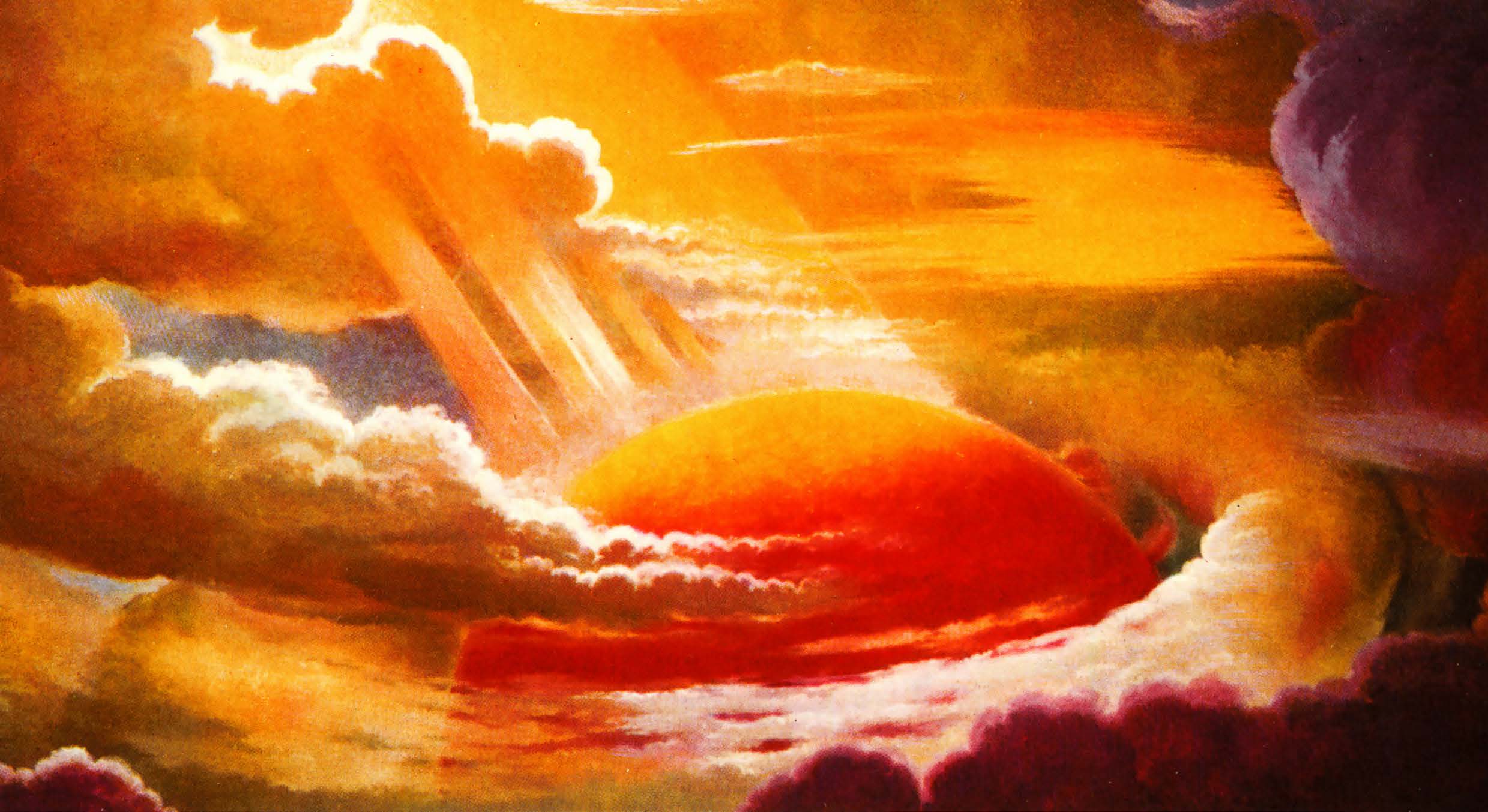
Following the lengthy closures in 2002 and 2005–2006, temple president Richard Andrus and other leaders felt the need to help the Saints to reestablish their pattern of regular temple service. To accomplish this, and to commemorate the temple’s “jubilee,” or fiftieth, anniversary in 2006, each of the forty-three stakes in the temple district was invited to plan a Commemoration Day on a designated Saturday beginning in October 2006 and running through December of the following year. The purpose of this event was “to show gratitude to the Lord for the privilege of having the Los Angeles Temple for the past fifty years and to increase the membership worthy and desirous of regularly attending the temple.”
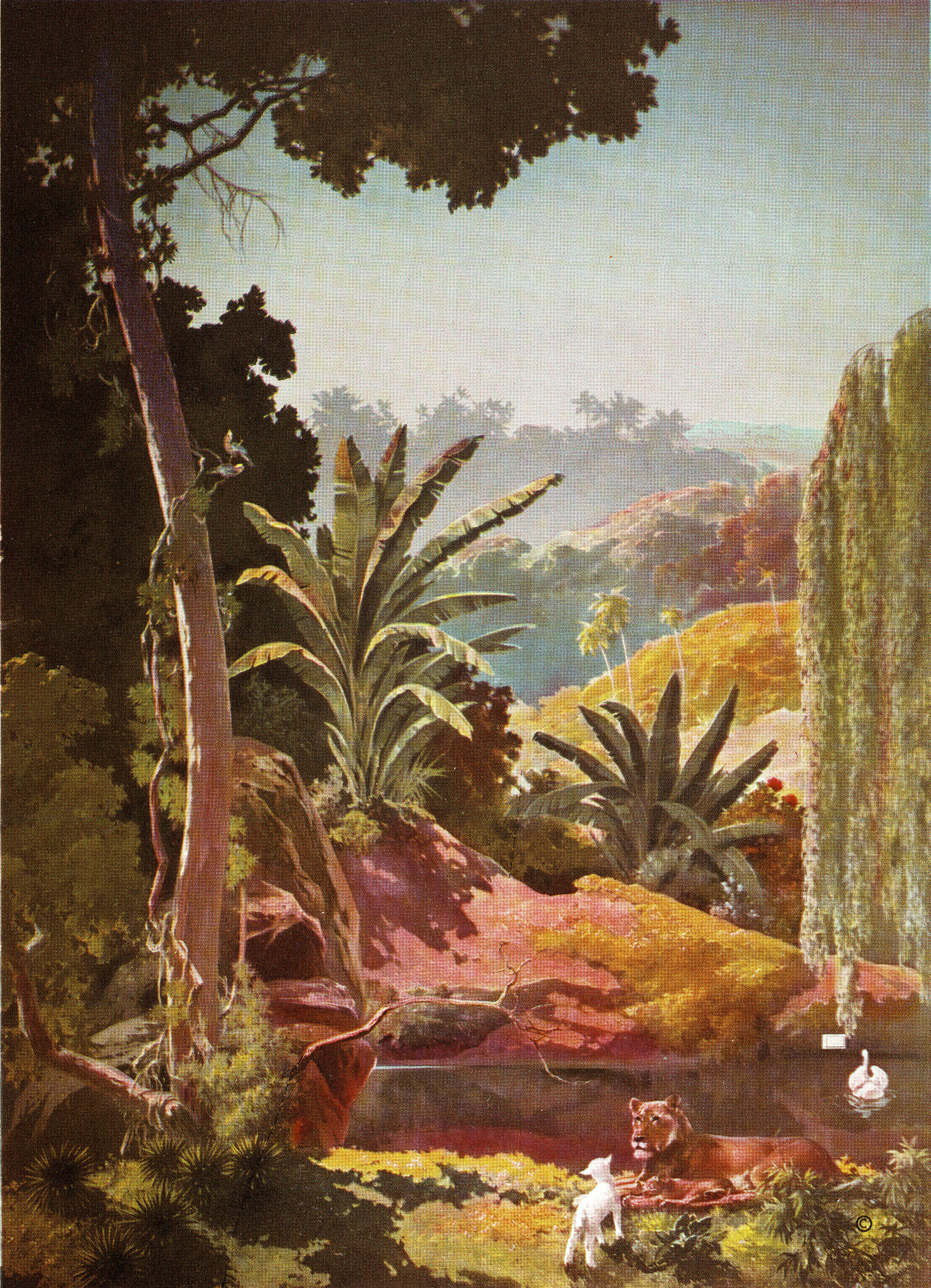 Murals from the garden room.
Murals from the garden room.
(© Intellectual Reserve, Inc.)
Stake members who were current temple goers were invited to attend a special stake endowment session. Those without temple recommends were urged to put their lives in order so that they too could participate. Stake leaders would be trained and set apart to help officiate during these special sessions. Baptistry, initiatory, and sealing facilities were available for adult stake members to perform saving ordinances for deceased family members. There would be a special worship meeting for each stake following the endowment session. The First Presidency gave the unusual permission for this hour-long meeting to take place in the large assembly hall on the third floor. The temple president, matron, and stake president would address the group. Each stake had the opportunity to provide its own choir for the occasion. “Some of the choirs were large while others were very small,” Darlene Andrus, the temple matron, recalled, “but that didn’t matter because the angels were there singing with them.” She recalled a similar experience in that same room fifty years earlier during the temple’s dedication.[39] For larger stakes whose members could not be accommodated in just one endowment session, a second session was scheduled to follow the worship meeting. Each stake also conducted a gathering on another day for the youth with music, appealing speakers, and refreshments. Hence on their stake Commemoration Day the youth were available to care for the children of those going to the temple. Across the district, over 2,000 members who did not have temple recommends obtained them and participated. An average of over 450 persons per stake took part in the commemorative temple sessions. Church leaders declared that there would be added spiritual blessings as the Saints took names of their own ancestors or other family members to the temple [40] The temple presidency specifically anticipated that having more temple workers in the stake and more members participate in temple service would allow “the Spirit of the Lord [to] touch hearts in a greater way and lift the Saints to a higher level of spirituality.”[41]
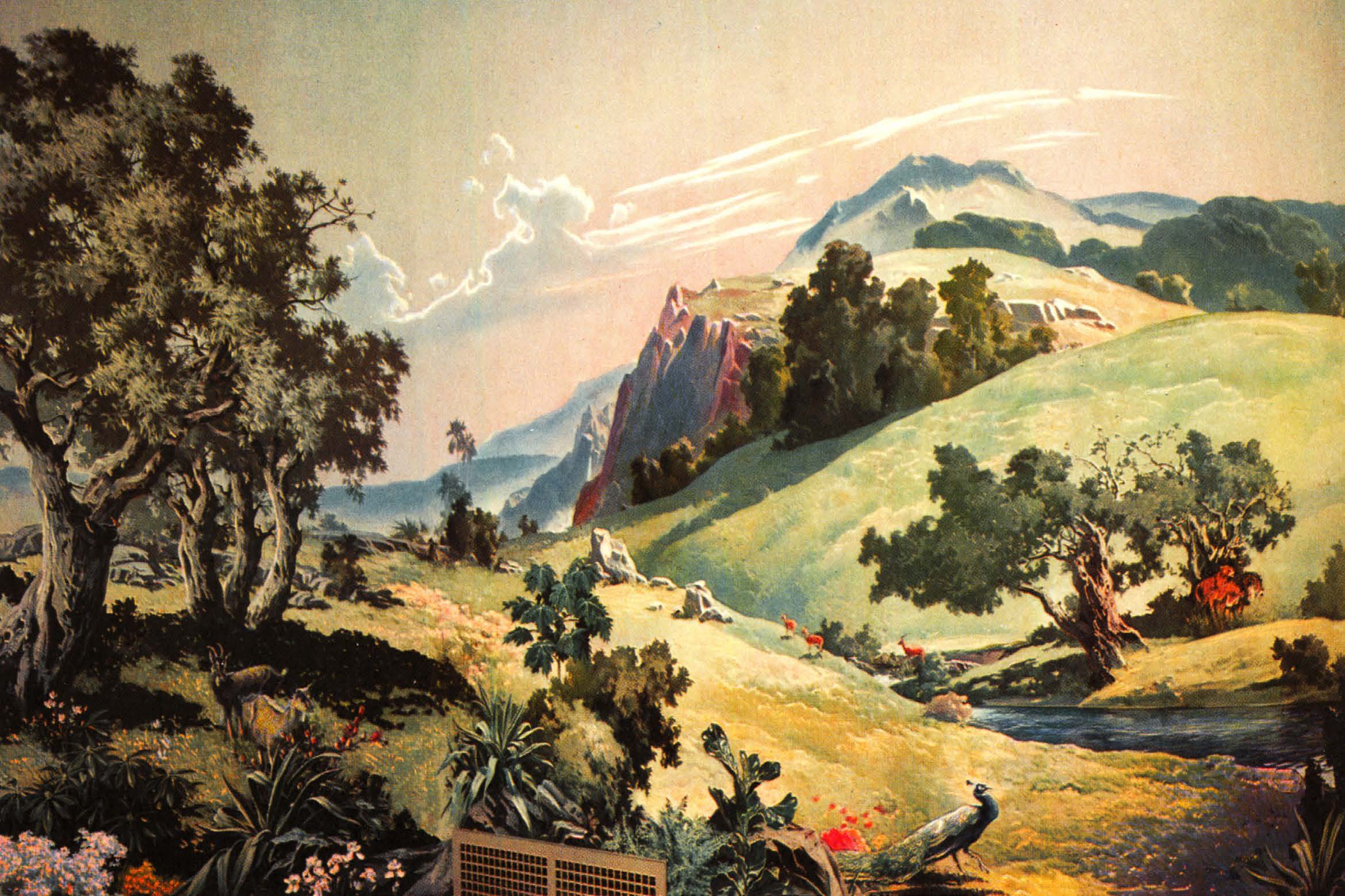
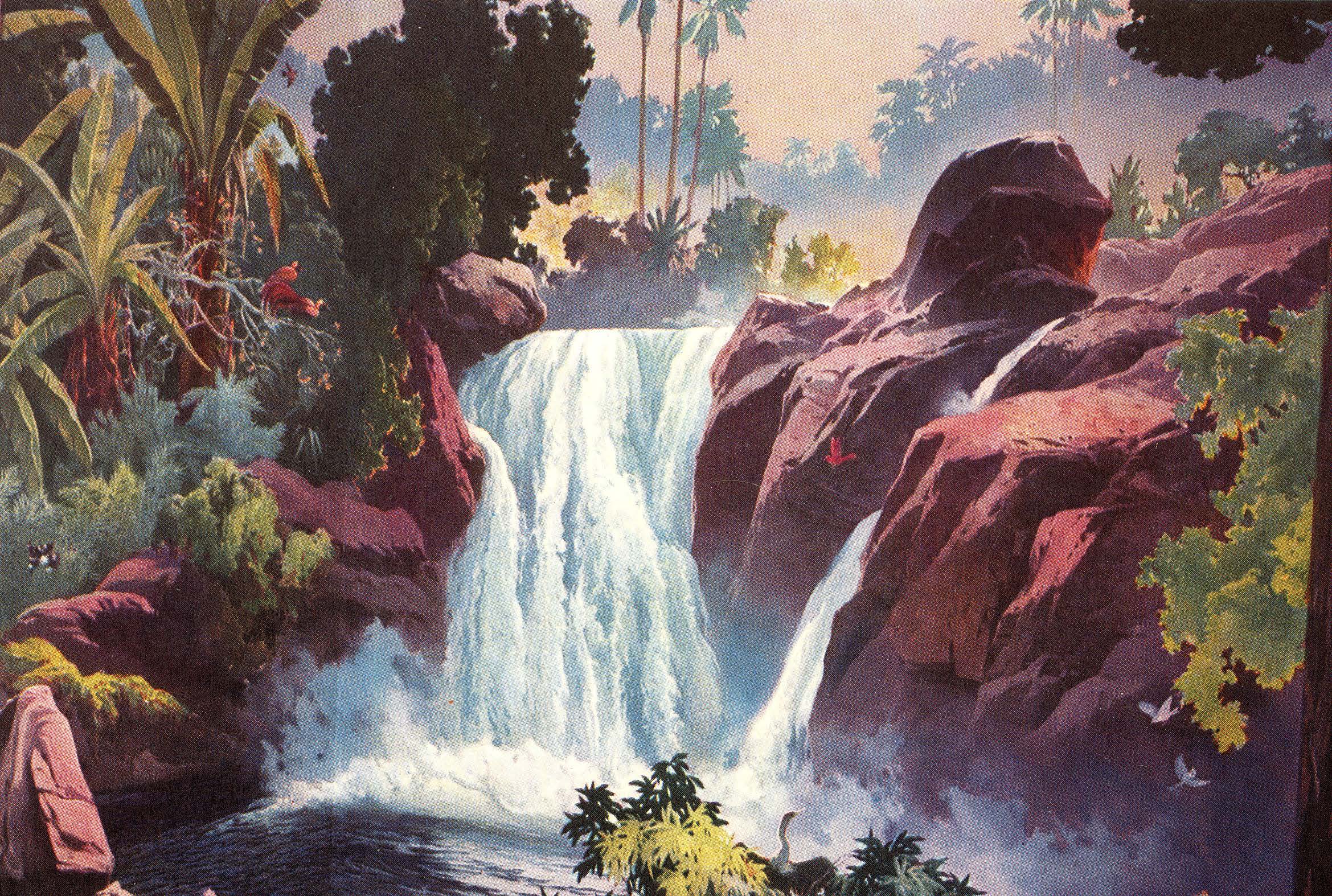
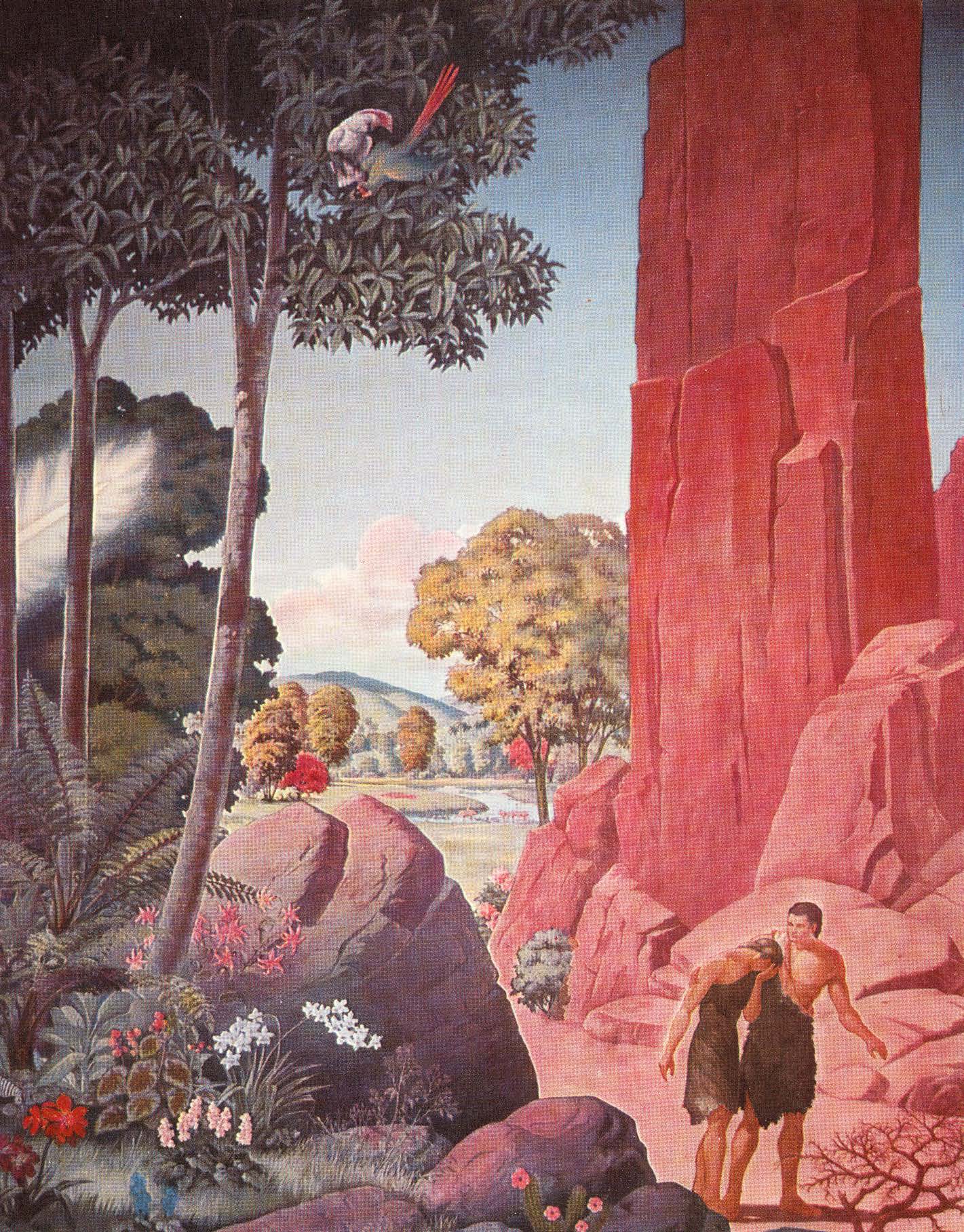
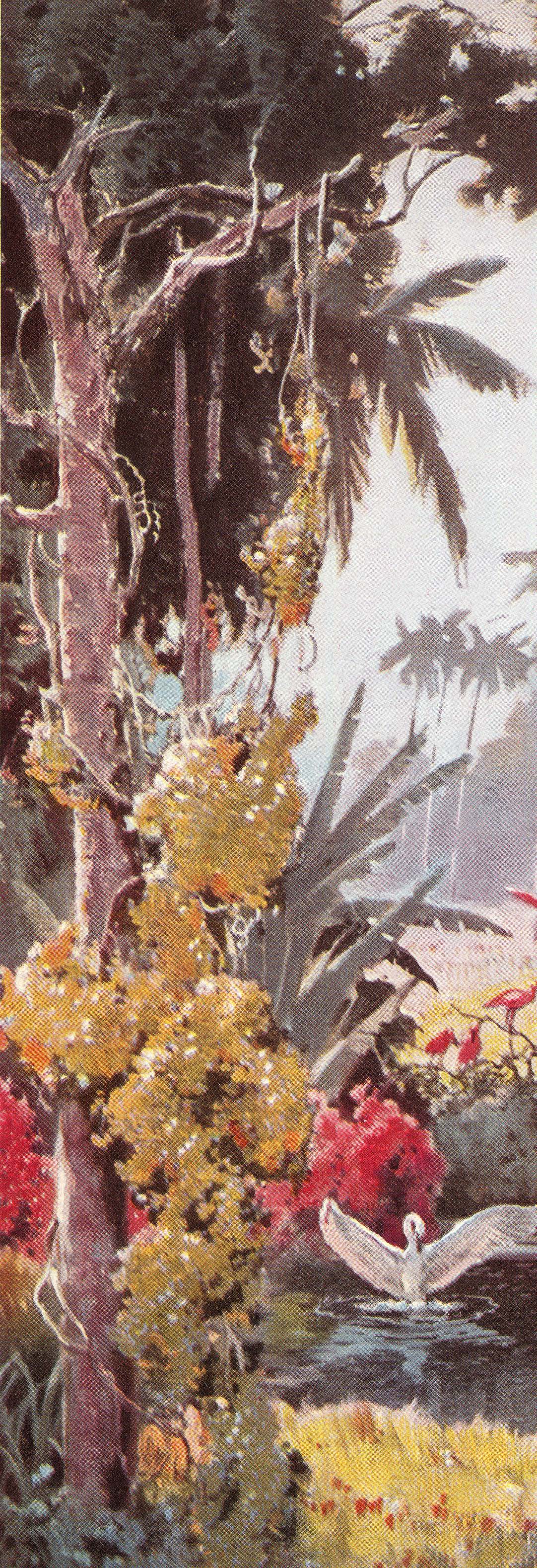
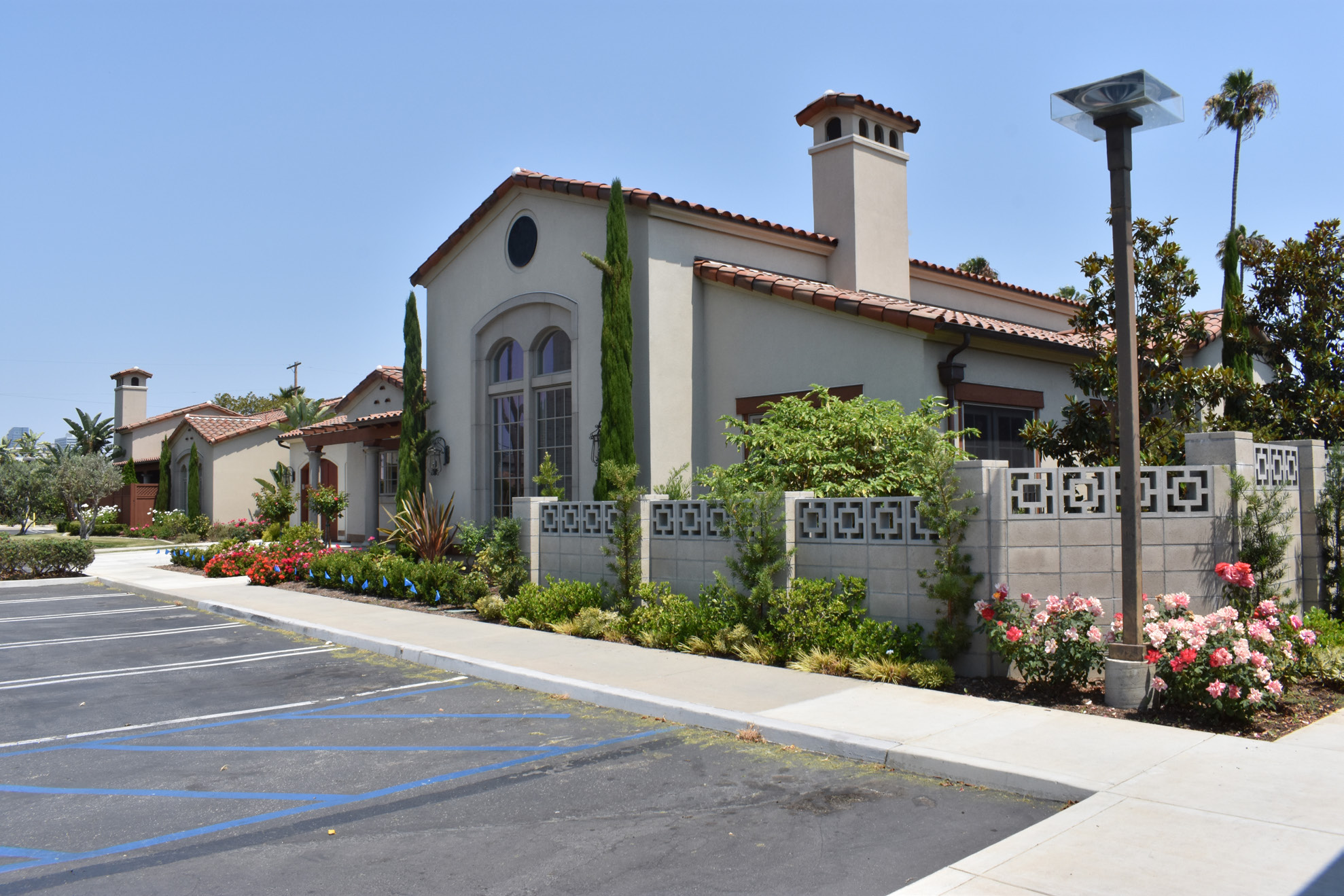 The temple president’s home with the mission president’s home behind. (Katie Hendrickson)
The temple president’s home with the mission president’s home behind. (Katie Hendrickson)
Another construction project became necessary. Temple presidents often needed to travel long distances through Southern California’s heavy traffic to reach the temple. For some time, a home or apartment had been provided for them in the immediate neighborhood. Also, throughout the Church there had been a trend away from housing mission presidents and their families in the same large building with the mission office and its staff. Furthermore, the mission home on the temple site was nearly sixty years old and needed significant upgrading. Therefore Church leaders decided to remove this older mission headquarters, and in its place build separate new homes for the temple and mission presidents. The California Los Angeles Mission office was moved to the basement of the visitors’ center, and the missionaries comprising its staff were housed in apartments in the area. The two new homes were completed in 2012.
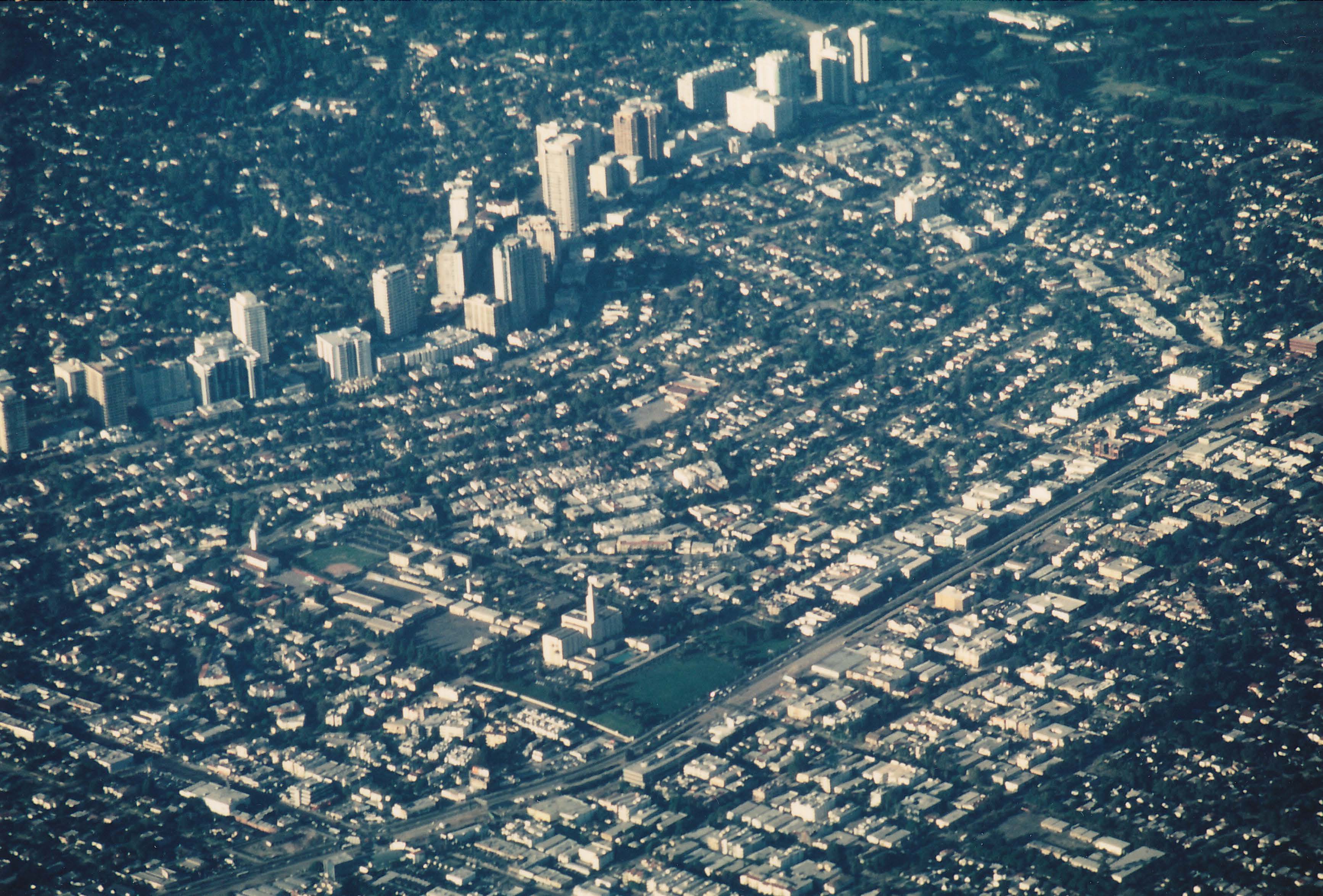 The temple as seen from above (note the growth of the Wilshire business district). (Courtesy of Glenna Walker White)
The temple as seen from above (note the growth of the Wilshire business district). (Courtesy of Glenna Walker White)
Even after the advent of the newer temples had cut the number of stakes served by the Los Angeles Temple about in half, some Saints still needed to travel long distances. Church members in San Luis Obispo, for example, needed to travel over 180 miles to reach the temple. To help with these lengthy trips, in 2016 stakes in San Luis Obispo and Santa Maria were chartering a bus to the temple each month.
Reconstruction and other developments in the temple unquestionably enhanced the Saints’ own experience there. Meanwhile, features and facilities on the surrounding grounds enabled the Church to reach out, build bridges, and become a source of blessing to the broader community as well.
Notes
[1] “Elder Derbyshire Named L.A. Temple Engineer,” Church News, June 25, 1955, 10.
[2] “Benjamin L. Bowring Named President, Elder Steed Chosen,” Church News, December 3, 1955, 2; “President Bowring Begins Work at L.A. Temple,” Church News, December 31, 1955, 5. See appendices M and L for further information on the sixteen presidents of the Los Angeles Temple.
[3] “A. Bent Peterson: L.A. Temple Recorder,” Church News, December 17, 1955, 5.
[4] “Los Angeles Temple Now Fully Staffed,” Church News, October 20, 1956, 6.
[5] Ned Redding, “Los Angeles Temple Counselors Chosen,” Church News, August 18, 1956, 2; for a complete list of temple leaders, see appendix M.
[6] “First Presidency Names Committee to Advise on L.A. Temple, Mission,” Church News, April 21, 1956, 6; John M. Russon “Recollections,” California Intermountain News, March 11, 1971, 12.
[7] Carrl Fox-Heidelberg, “28 Years of Service: Lilo Schiel Retires as Temple Executive Secretary,” Latter-Day Sentinel, January 31, 1987, 4.
[8] Los Angeles Temple Presidency to Rosetta Wittorf, October 11, 2007, copy in possession of author.
[9] Eleanor Knowles, Howard W. Hunter (Salt Lake City: Deseret Book, 1994), 134.
[10] “First Marriage Performed in New Los Angeles Temple,” Church News, April 7, 1956, 7.
[11] James E. Talmage, The House of the Lord (Salt Lake City: Bookcraft, 1962), 100.
[12] John A. Widtsoe, Program of the Church (Salt Lake City: Church Department of Education, 1937), 178.
[13] Boyd K. Packer, You May Claim the Blessings of the Holy Temple (Salt Lake City: Bookcraft, 1980), 153.
[14] Church News, July 23, 1952, 2; Church News, July 30, 1952, 1; Church News, April 11, 1953, 7.
[15] Harold W. Burton, “Architectural Features of the Oakland Temple of The Church of Jesus Christ of Latter-day Saints,” MS 4235, folder 1, Church History Library, 6.
[16] Sheri L. Dew, Go Forward with Faith: The Biography of Gordon B. Hinckley (Salt Lake City: Deseret Book, 1996), 176–77.
[17] David O. McKay, Dedication Proceedings, New Zealand Temple, April 20– 23, 1958. MS, LDS Church Archives, quoted in Richard O. Cowan, Temples to Dot the Earth (Springville, UT: Cedar Fort, 2011), 177.
[18] “Pres. MacKay Member of First Group,” Church News, April 21, 1956, 3.
[19] Gregory A. Prince and Wm. Robert Wright, David O. McKay and the Rise of Modern Mormonism (Salt Lake City: University of Utah Press, 2005), 260.
[20] “Temple Opening: Pres. McKay Member of First Group,” Church News, April 21, 1956, 3.
[21] “Date Announced for Baptisms and Endowments,” Church News, March 10, 1956, 2; “L.A. Temple Opens for Ordinances,” Church News April 14, 1956, 18.
[22] “German Immigrants Receive Aid from Los Angeles Group,” Church News, May 12, 1962, 5.
[23] Henry A. Smith, “Another Language Story,” Church News, April 7, 1962, 5.
[24] “Sacramento Stake Sponsors Temple Excursion,” Church News, January 17, 1957, 7; “Oregon Members Take Excursion to L.A. Temple,” Church News, February 23, 1957, 7; “Oregon Members Visit L.A. Temple,” Church News, April 6, 1957, 10; “Klammath Organizes Temple Caravan,” Church News, March 25, 1961, 5.
[25] “LDS Servicemen from Ft. Ord Attend L.A. Temple Session,” Church News, April 4, 1959, 19.
[26] “San Mateo Youths Join Trip to Los Angeles Temple,” Church News, December 21, 1957, 5; “Columbia River Youths Take Trip to Temple,” Church News, August 4, 1962, 5.
[27] “Elder Hanks Talks to Graduates in San Luis Obispo,” Church News, May 24, 1958, 12; “Concord Seniors Motivated to Enter Temple,” Church News, December 10, 1960, 13; “Eight Redondo Couples Graduate from School,” Church News, November 10, 1962, 5; “35 Orange County Couples Sealed in L.A. Temple,” Church News, April 18, 1964, 10.
[28] John L Hart, “Time of Sealing, Healing,” Church News, August 31, 1986, 16.
[29] “L.A. Temple Sets Record at Special All-Male Session,” Church News, October 25, 1958, 15; George L. Scott, “‘Male Only’ Sessions Held in L.A. Temple,” Church News, May 16, 1959, 12; Henry A. Smith, “As We See It . . . A Temple Record,” Church News, December 4, 1964, 6.
[30] “Solemn Assembly: 2600 Attend Special L.A. Temple Meeting” and “Four Church Workers Killed in Plane Crash,” Church News, June 15, 1957, 3, 7.
[31] Orton, More Faith Than Fear, 244; Los Angeles Temple Apartments Built for Patrons,” Church News, February 27, 1965, 12.
[32] Don P. Christiansen, “L.A. Temple—25 Years Later,” Church News, March 28, 1981, 3; Chad L. Orton, More Faith Than Fear: The Los Angeles Stake Story (Salt Lake City: Deseret Book, 1987), 320, 321.
[33] Program for 25th anniversary celebration, copy in author’s possession.
[34] Melba B. Swift, “Moroni Gets a New Gold Overcoat on L.A. Temple,” Church News, March 27, 1982, 13.
[35] Carrl Fox-Heidelberg, “LA Temple Goes High-Tech: Computers Installed This Year,” Latter-Day Sentinel, March 16, 1985, 5.
[36] “Temple Sustains Minor Damage,” Church News, January 22, 1994, 3.
[37] North America West Area Presidency to stake presidents in the Los Angeles Temple district, April 25, 2001; copy in possession of the author.
[38] See Richard M. Andrus, personal account, copy of manuscript in possession of the author.
[39] Darlene H. Andrus, interview by Marilyn Mills, March 20, 2017, audio recording in possession of the author.
[40] “Stakes Will Celebrate L.A. Temple’s 50th Anniversary with Individual Commemoration Days through 2007,” Latter-day Trumpet, October 2006, 1.
[41] Richard Andrus, temple president, letter to stake presidents, March 2, 2007.